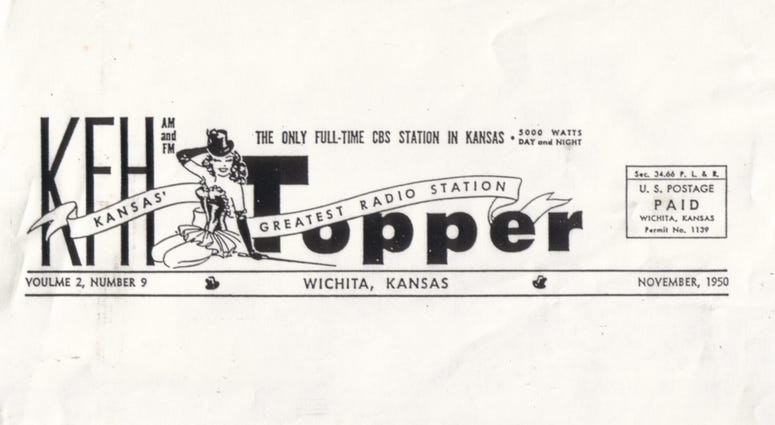
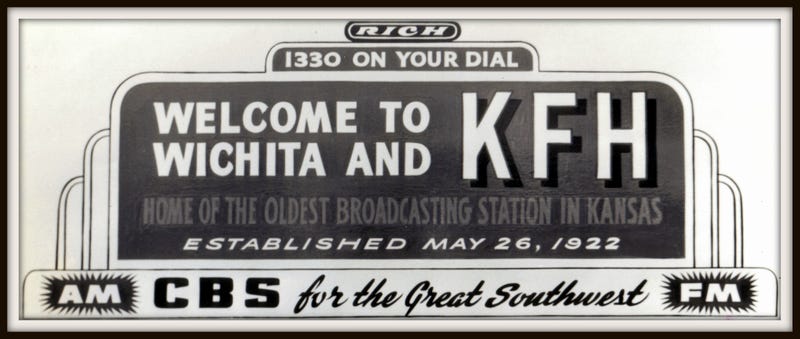
Historical photos can be found at the KFH Facebook site: CLICK HERE plus: https://archive.org/search.php?query=kfh
Listen to "This is Wichita" shows that aired on KFH in early 1940s! https://archive.org/details/this-is-wichita_20200504
OWNERSHIP: KFH was first known as WEAH and was set into existence by the Lander Radio Company in March 1922, for the purpose of broadcasting market reports starting April 1, 1922.
On April 21, 1922, an application was filed by the Wichita Board of Trade and Lander Radio Company for a license to broadcast crop and market reports. The application was filed with the agency handling radio broadcast licenses at the time, the Radio Division of the Bureau of Navigation, US Department of Commerce.
The call letters of WEAH were issued and the station first went on the air May 26, 1922. The physical location of the station was listed as 507 Bitting Building, 120 S. Market, in downtown Wichita. The equipment was built and installed by Francis J. Lander and D.M. Good of the Lander Radio Company, and the station was inititally under the supervision of R.B. Waltermire, Secretary of the Wichita Board of Trade and R.H. Riner, station director and announcer. The station initially broadcast only on 833 kilocycles (360 meters) where they shared time with two other early Wichita stations, WEY and WAAP. Later that same year, the station was given permission to broadcast market news and weather information on 618 kilocycles (485 meters) where they did not have to share time with the other two stations. 833 kilocycles continued to be used for entertainment programming.
WEAH was sold to the Board of Trade on June 23, 1923. On April 30, 1925, the Rigby Gray Hotel Company Corporation (operator of the Lassen Hotel) purchased WEAH and changed the call letters to KFH (Kansas’ Finest Hotel). The first radio broadcast under the call letters KFH commenced at 9:45am, February 14, 1926.
The Wichita Eagle (newspaper) purchased 50% of KFH on October 1, 1929. KFH became an affiliate with Columbia Broadcasting Company (CBS) on October 8, 1929.
On June 5, 1963, the FCC granted the license transfer to Aeschlayer & Reynolds of Dallas, Texas.
On November 1, 1968, KFH was sold to KFH Radio, Inc. and was owned by Phil and Nancy Kassebaum, Tom Bashaw Sr, and Bob Adams.
On October 19, 1988, Midcontinent Broadcasting Company of Kansas purchased KFH.
Ownership of KFH was sold to Pourtales Radio Partnership on July 1, 1994.
A letter of intent to sell KFH to Triathlon Broadcasting was signed Friday, March 24, 1995. The sell was completed June 2, 1995.
As of February 23, 2000, KFH Radio is under the ownership of Entercom Wichita, LLC (Audacy)
FREQUENCY:
KFH AM was first assigned 1120 on the AM dial with 500 watts of power operating only during daylight hours. On April 27, 1927, KFH’s frequency was changed to 1220 and by November 13, 1928, the station was operating on 1300 under a time-share with WIBW in Topeka. KFH’s power was increased from 1000 to 5000 watts on May 28, 1935, but the actual license was not issued until July 17, 1936, granting 5000 watts day and 1000 watts night. It was not until 1940 that KFH received FCC approval to operating with 5000 watts both day and night, and in 1941 the frequency was shifted to 1330. FCC records show KFH was assigned 1240 AM in 1959 for emergency purposes. On August 30th 2004 at 12:00am, KFH AM moved from 1330 AM to 1240 AM.
KFH FM first went on the air in 1948 on the frequency of 100.3 MHz, at 11,000 effective radiated power. In the mid 1960’s KFH was ordered by the FCC to provide separate programming to AM and FM. The new FM format was “underground” (album-oriented) rock. In the early 1970’s KFH FM changed frequency to 97.9 MHz, increased ERP power to 100kw … started broadcasting in stereo under the call letters of KBRA where they played “beautiful music.” In 2002 KFH FM returned, broadcasting at 98.7 FM. Today KFH FM is at 97.5 FM, simulcasting KFH AM.
FIRSTS:
KFH is the oldest commercially licensed radio station in Kansas.
KFH was the first station in Kansas to add FM to its broadcast service.
KFH was the first radio station in Kansas to originate a network broadcast that was carried nationwide.
KFH was the first radio station in Kansas to provide continuous weather coverage during tornado warnings for citizens in its coverage area.
KFH was the first radio station in Kansas to use an airplane to provide live coverage of special events, and to cover disasters and emergencies.
Larry Stanley - The first fulltime sports director for KFH Radio.
Larry served the station as sports director from 1937 to 1950.
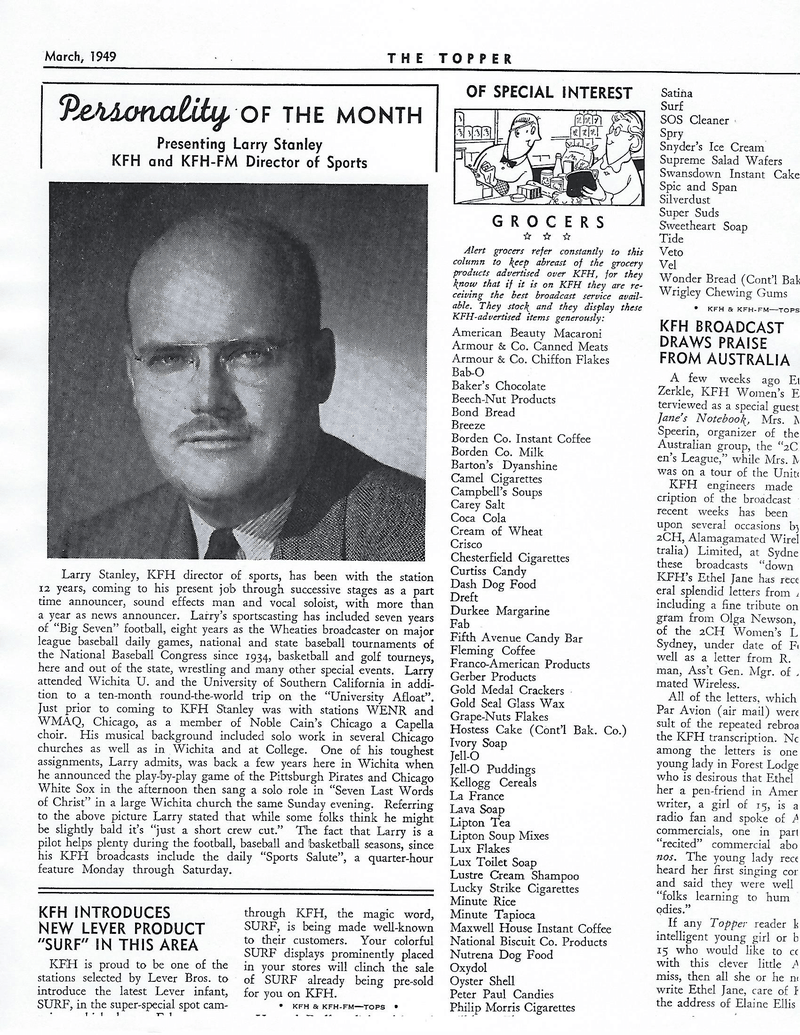
George Wells – In 1957, KFH’s Party Line was hosted by George Wells weeknights in the 7pm hour. Listeners called the station to discuss many topics, from current news to personal issues. In less than 4-weeks after going on the air, Party Line was a huge success.
(2 pic of men below) George Wells is in the KFH studio with Kansas Governor William Avery. 1966.
Bruce Behymer – Bruce was Farm Director at KFH for over 25 years. He also was Market Editor at the Wichita Eagle for at least 45 years. When Bruce was on the air, he was the most listened to personality on Wichita Radio. Bruce’s Farm World Today broadcast daily in the 6am hour. Bruce would start broadcasts with a well-know cow bell.
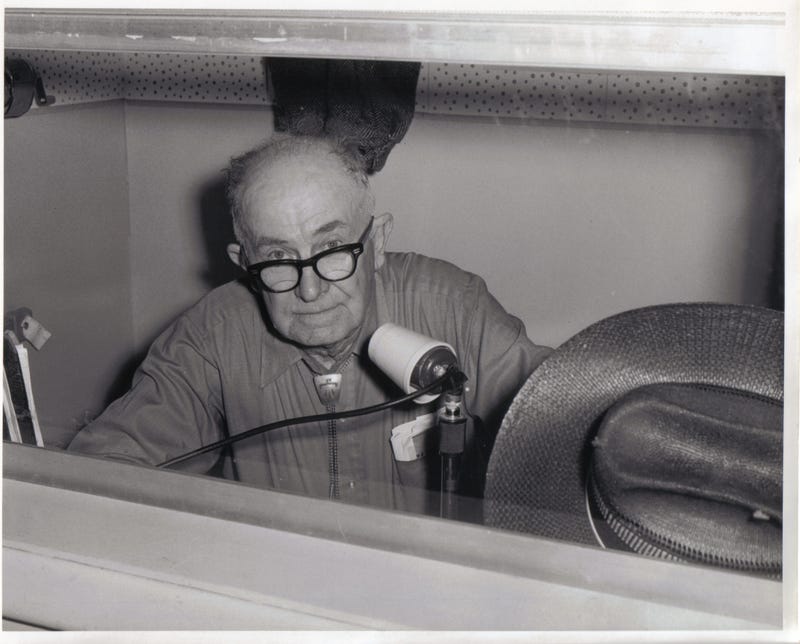
Don Anderson – From July 1949 going into the 1960s, Don was a very popular personality on KFH. Don was also Program Director of KFH. His show “Don Anderson Show” aired 3:45pm-5:45pm. The Don Anderson Show included popular music, humor and talk, including a character named “Ola.” Don was also the “Polka King,” a daily show devoted to polka music and news that appealed to women.
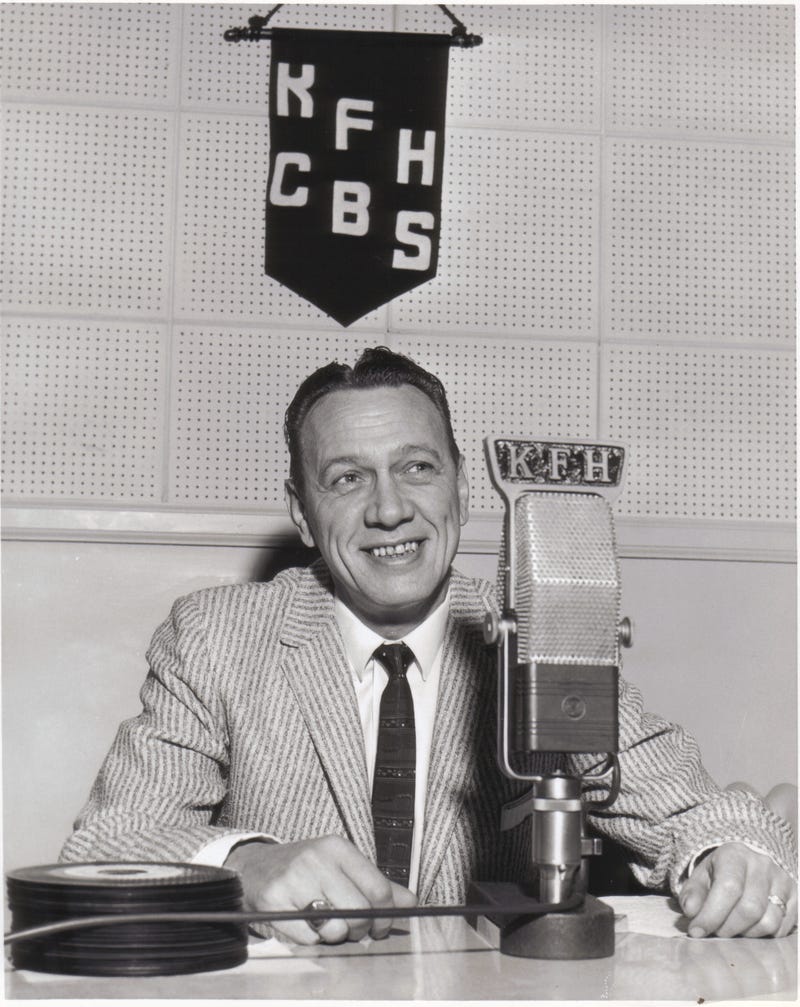
Tom Bashaw – Tom was associated with KFH starting in 1949, first as Program Director and later as Sales Manager, and then in 1955 as General Manager. At one time Tom worked at the famed WLS in Chicago.
(pic of two men shaking hands) Tom Bashaw, KFH GM, welcomes Johnny Merrell as Sales Manager. 1949.
Jack Barry / Barry Gaston – Barry held many hats with KFH Radio. Born in Kansas City, moving to Wichita in 1943, Barry attended grade, high school and Wichita University (WSU) in Wichita. First coming to KFH at age 16, Barry was a newscaster, DJ, and General Manager. Part of his on-air duties, Barry was the man with the “traveling mic.” Interviews were made from many locations, including from top of buildings, in a tiger cage at the zoo, and from Hollywood talking with movie stars! Barry hosted an evening show titled “Nightline” where many Hollywood stars talked live on the air with “Jack.”
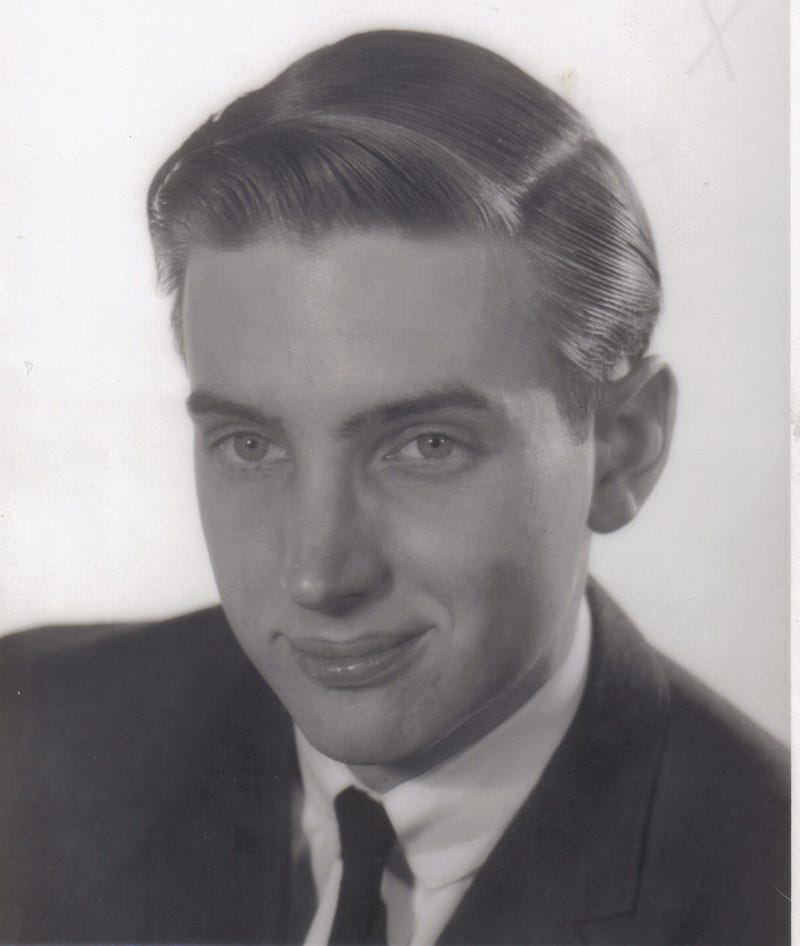
Johnny Merrell – The Johnny Merrell Show aired weekdays 6:45am-9:30am on KFH. Then he hosted KFH’s Morning Party Line from 9:30am-10:00am. Johnny had been identified with KFH since 1956, coming on as Sales Manager. Before that he worked for Wichita radio station KWBB as Sales Manager. Johnny was well known for ad-libbing live commercial spots. A sponsor would not purchase commercials but would instead buy the ability for Johnny to talk about that sponsor.
He served in the US Air Force during WWII. Johnny’s interest in flying continued as pilot of the KFH News Sattelite (spelled this way in the 1950s), flying all across the country covering various stories. Johnny Merrell was also known as "The Morning Mayor."
Johnny Sanders – Came to KFH January of 1962. Johnny was considered one of the most likable and witty announcers on KFH. Johnny hosted an early morning weekday show from 6:45am-9:00am, and then returned to the air at 1:00pm-3:00pm. Johnny was known for his familiarity with the music he played. Many KFH listeners knew Johnny as “Wichita’s Morning Mayor.” Weatherman Cecil Carrier was part of Johnny’s morning show.
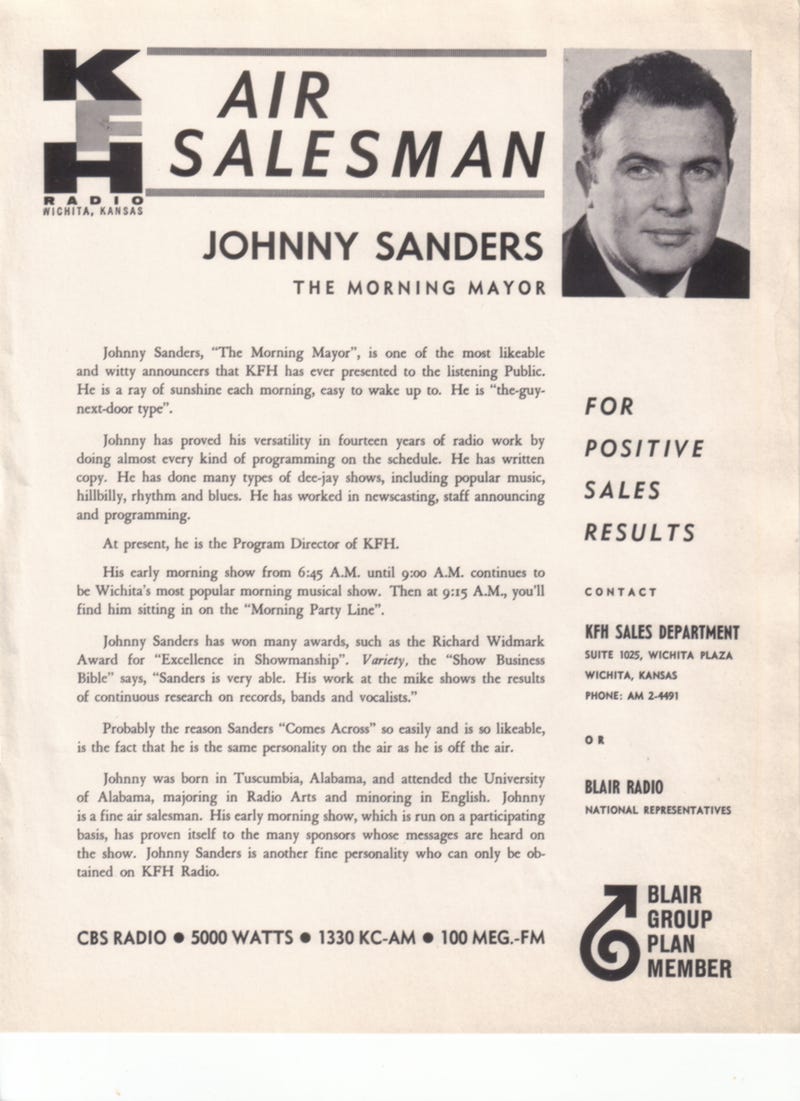
John Rigby – Owner. KFH was first known as WEAH and was set into existence by the Lander Radio Company in March 1922, for the purpose of broadcasting market reports starting April 1, 1922.
WEAH was sold to the Board of Trade on June 23, 1923. On April 30, 1925, the Rigby Gray Hotel Company Corporation (operator of the Lassen Hotel) purchased WEAH and changed the call letters to KFH (Kansas’ Finest Hotel). The first radio broadcast under the call letters KFH commenced at 9:45am, February 14, 1926.
John Rigby, former Wichitan, lived in Beverly Hills, California. He resided in Wichita from 1929 to 1935. He together with the late Richard Gray built the Lassen Hotel in 1918, opening it for business on New Year’s Day, 1919. Later the two of them purchased the radio station which they renamed KFH. He sold his Lassen interests in 1933 but retained his interest in the radio station.
The York Rite building, purchased early in 1945 by Radio station KFH Company, was known as the KFH Building. John Rigby was president of the KFH Company, Marcellus M. Murdock is vice-president, and Mrs. Anna Scott Gray was secretary. Rigby and the late Richard M. Gray, then operators of the Lassen Hotel, operated the station in 1925 at 50 watts power after purchasing it from WEAH. In January 1926 the station went to 500 watts at 1220 kilocycles, and on January 1, 1929 The Wichita Eagle became associated with KFH. The ownership had been the same since that time until early 1960s. In October 1929 KFH became the CBS outlet in this area and broadcast programs on 1300 kilocycles at 1000 watts, sharing time with WIBW in Topeka. In December of that year the station went on a five-sevenths time sharing basis with WOQ in Kansas City, and the studios were maintained in the Wheeler-Kelly-Hagney Building annex. KFH was granted a full time permit on 1300 kilocycles in June 1933. In July 1935 the downtown studios were moved to the location in the KFH building, and in July 1936 the station was granted a power increase to 5000 watts daytime and 1000 watts at nighttime. In September 1941 the Federal Communications Commission granted an increase to 5000 watts power output day and night.
John Rigby died Monday, November 12th 1962.
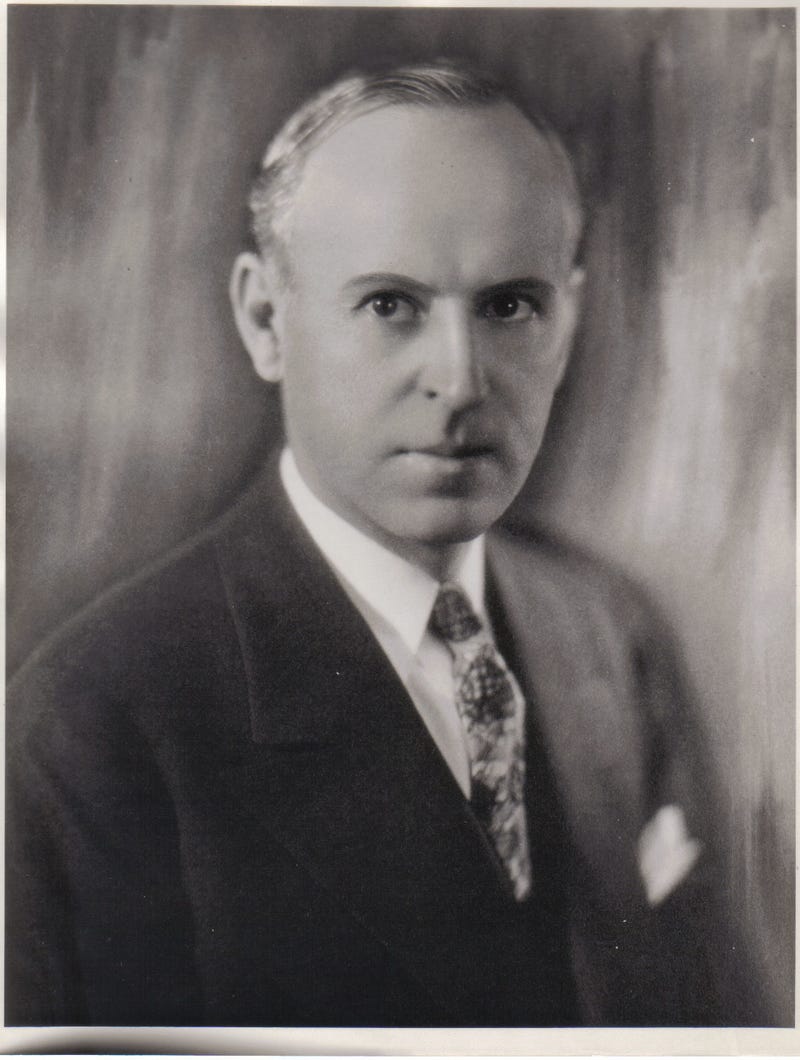
KFH’s Address –
1920s: Wheeler-Kelly-Hagney Building at 120 South Market
Late 1920s - Early 1930s: Lassen Hotel at 153 North Market
1935 – July 1963: KFH Building, SE corner of William and Market
1963-1970s: Kansas State Bank & Trust Company building, 125 N Market
1980s: Carey House Square, Douglas and Emporia
1989-1994: 626 North Broadway
1995-2015: Brittany Center 21st and Woodlawn
2016- Present: Entercom/Audacy Campus 9111 East Douglas
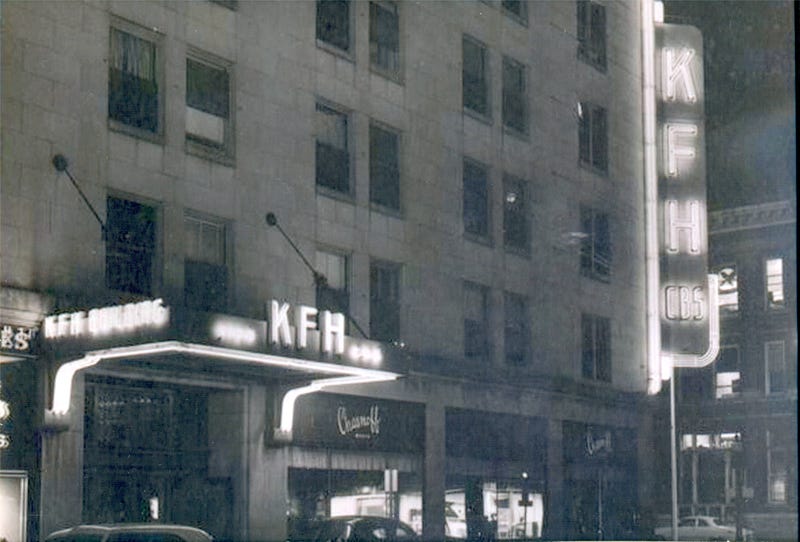
Phil and Nancy Landon Kassebaum – Owner, 1968-1988, Kassebaum Communications. Partners included Bob Adams, Tom Bashaw and John Rees who shared ownership with Phil and Nancy Kassebaum.
Nancy Kassebaum is pictured here with Steve McIntosh, live on KFH in 1993.
Marcellus M. Murdock - Owner
Marcellus Marion Murdock was born February 14, 1883, in Wichita, Kansas. As a boy he worked in the plant of the Wichita Eagle, the newspaper founded by his father, Col. Marshall Murdock, in 1872. After his 1902 graduation from Wichita High School Marcellus began his professional career with the Wichita Eagle. He worked as a reporter and editor before becoming publisher in 1906, after his father's retirement. His award-winning career in newspaper lasted more than sixty years. Murdock, a successful businessman in other ventures, was an accomplished pilot as well. He first learned to fly at the age of forty-six in 1929, the same year he purchased 50% of KFH, and continued his flying hobby well into his seventies. Marcellus Murdock died March 10, 1970.
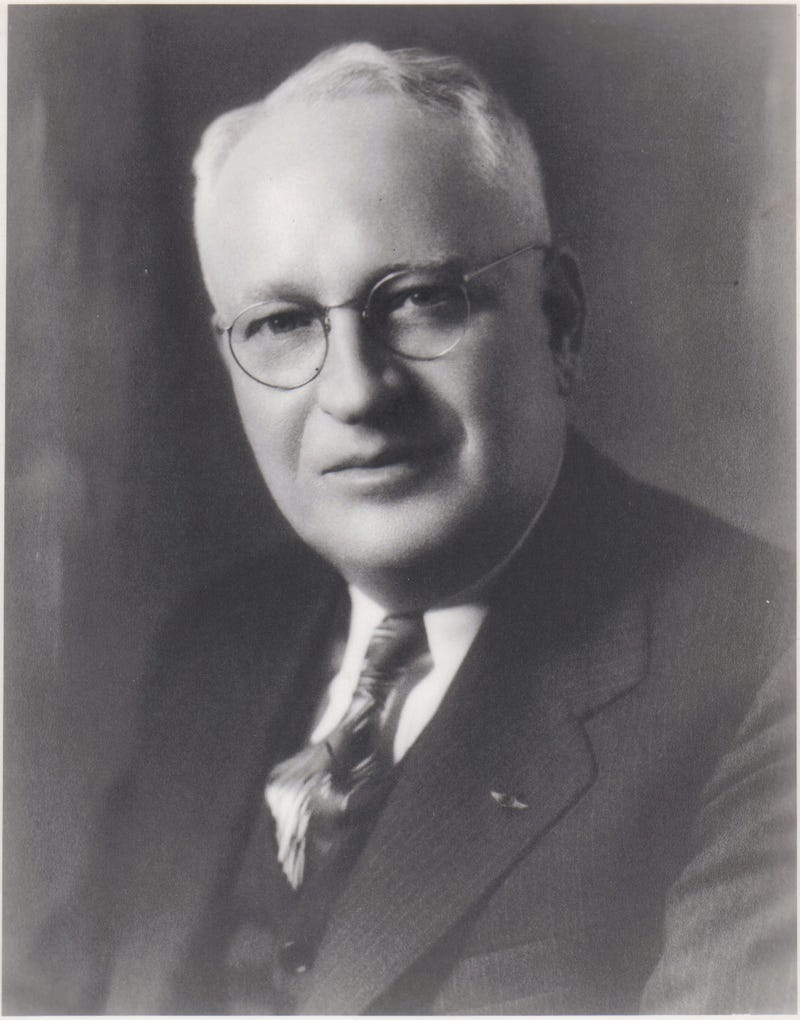
Bill Bailey – 1960s KFH Personality:
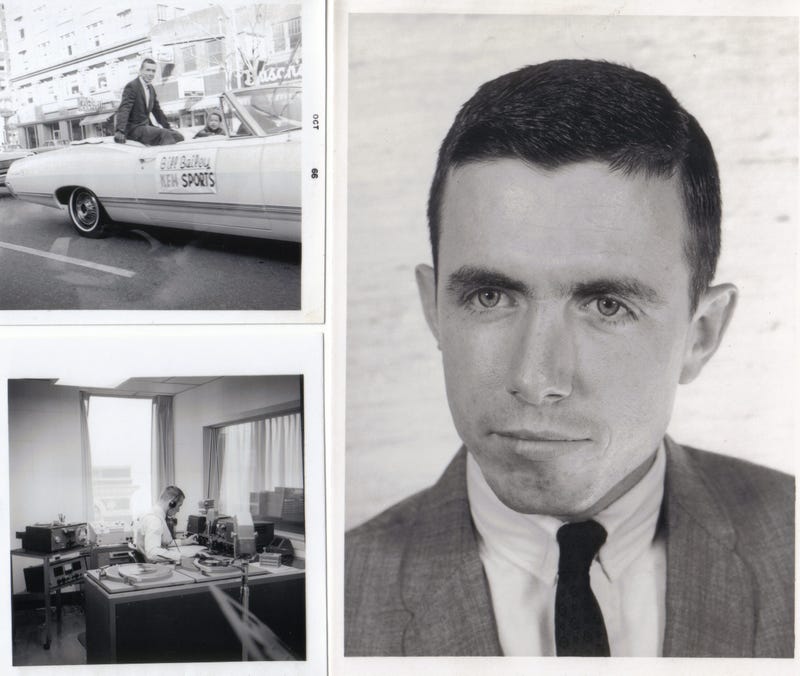
Blood Drive – From mid 1960s, KFH afternoon personality Bill Bailey was reading a public service announcement regarding blood donation. Bill noted on-air that he never gave blood and was a bit ashamed about it. At that moment Jack Barry, evening personality came in the studio and said he would give blood if Bill would. Bill then countered that he would give blood if the rest of the KFH personalities would. The “Chicken Bailey” campaign was born and in a two week run, Red Cross reported a big increase of donors. The female pictured is Playboy Magazine’s June Wilkinson. She called Bill on the air and said she would hold his hand while he gave blood.
Harold Bates – KFH Engineer:
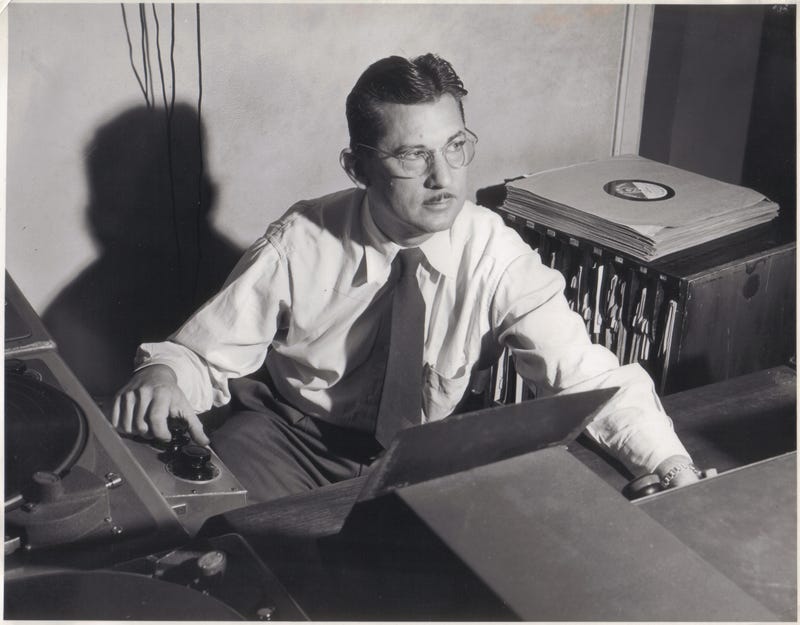
Les Campbell – KFH Engineer
Les was a long time engineer with KFH. From the 1950s through the 1980s, Les kept KFH on the air for many decades.
Les Campbell is sitting in a KFH studio:
Jason Drake – Program Director (1980s)
(pic with Bug car) Jason Drake at 81 Speedway at a KFH promotion!
(pic with award) Jason Drake accepting an award for KFH from Wichita Riverfestival’s Admiral Windwagon Smith.
(pic with 4 people) Jason Drake and John “Hooter” Myers at 81 Speedway.
KFH Staff from early 1980s – In the late 1970s through mid 1980s, KFH’s format was full-service, country music. Pictured in the middle with the checkered shirt is Jason Drake, KFH personality and Program Director. At the far right is morning personality John “Hooter” Myers. Next to John is Don Guidas. At the far left is the late Kevin Craig. Third from the left is Father Frank Stanton:
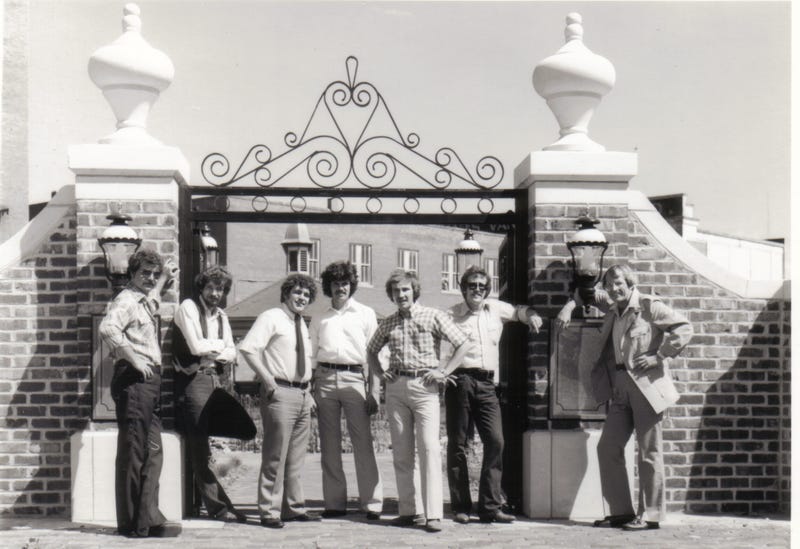
Gus Grebe – Sports
Voice of Shocker Sports in the 1960s and 1970s, Gus’ on-air trademark was “put it in the old deep freeze” used whenever he declared a game over.
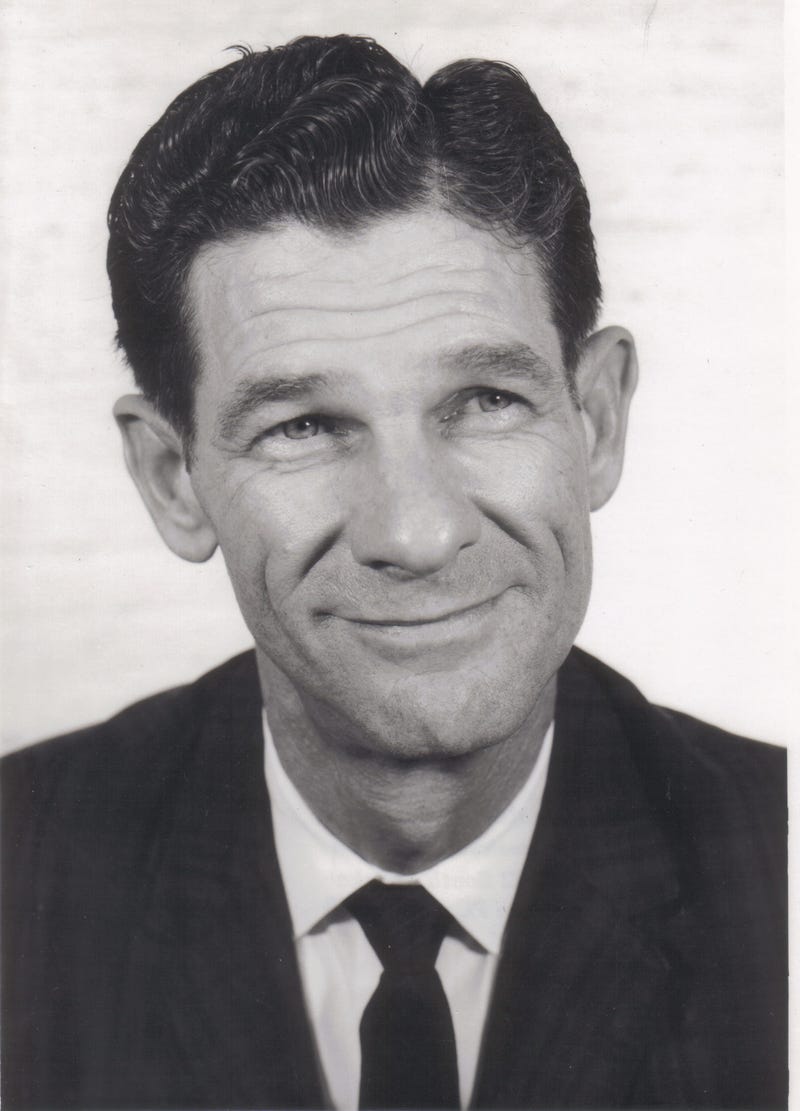
Frank Gunn – KFH Personality:
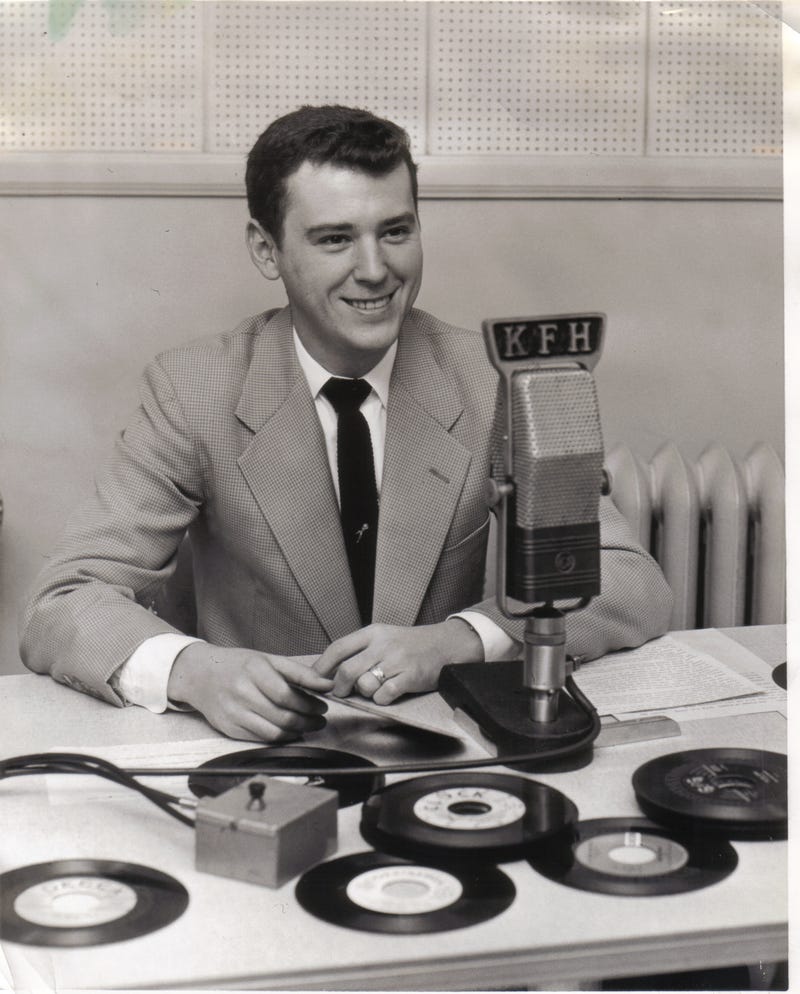
KFH Tower and Transmitter Equipment – located at 13th and Rock Road
Art Bell – KFH Personality. In the early 1990s, KFH changed formats to feature an all-talk show lineup. One of the first shows KFH put on during this time was Coast To Coast AM with Art Bell. Live overnight talk radio from all across the country is what sold KFH Program Director Tony Duesing. The show is still on in syndication from ‘coast to coast’.
Ron Shank – KFH Personality. From 1989 – 1991, KFH featured ‘oldies’ rock music from the 1950s era – early 1970s era. Ron’s show “The Rocket Sled of Entertainment” became a big hit for evening radio listeners. There was nothing on the air like Ron’s heavy personality-driven show. Before leaving radio, Ron was awarded Best Radio Personality in Kansas by the Kansas Association of Broadcasters. Movie Mark was a contributor to the Rocket Sled of Entertainment.
(pic below) One very hot day Ron decided it was so hot that you could fry food on the sidewalk. The Rocket Sled of Entertainment Pancake Feed was born:

Steve McIntosh – Steve’s stint in radio began in 1970. He covered many Wichita news stories. Steve came to KFH in 1980 and was News Director until 1986. In early 1990, Steve was again employed with KFH as News Director and also host of a live weekday show titled “Mac Live.” Today, Steve is very much involved with Wichita radio. He is host of the successful Morning NewsWatch on KNSS.
(pic below with woman) Steve pictured here with movie and TV start Linda Blair. Linda was in town for a fundraiser and stopped by to speak on Steve’s talk show, Mac Live.
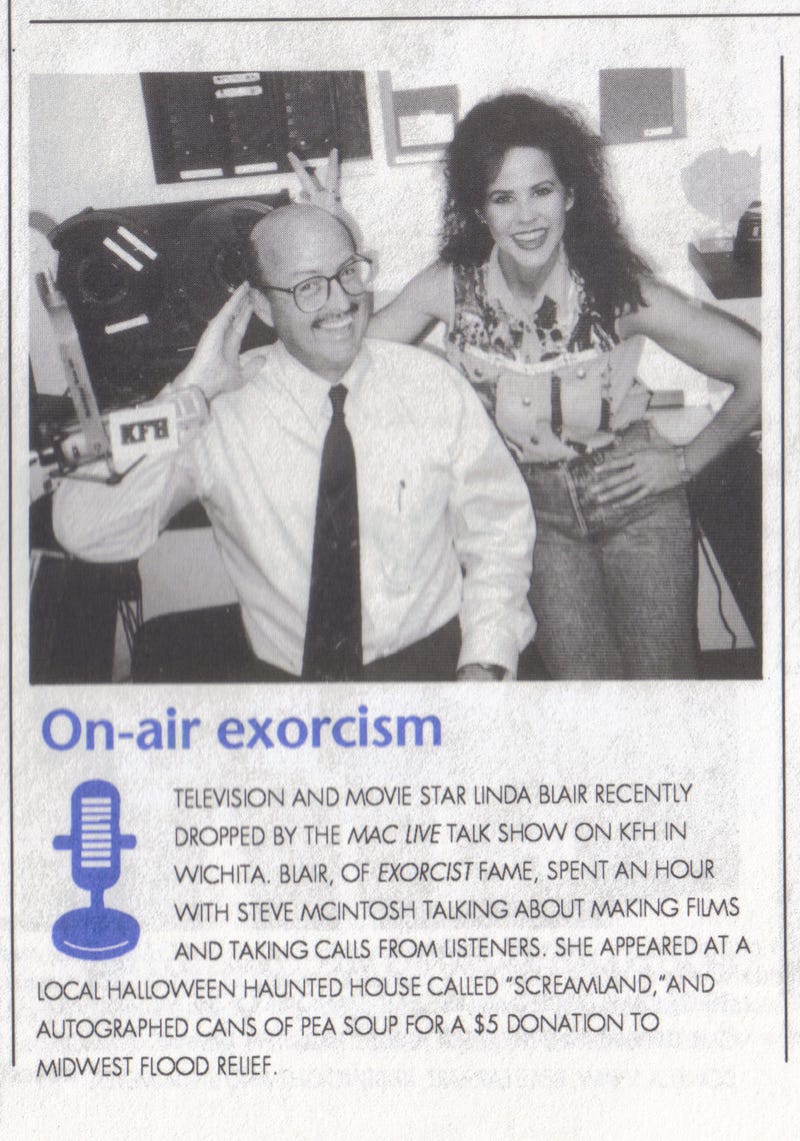
KFH Vehicles
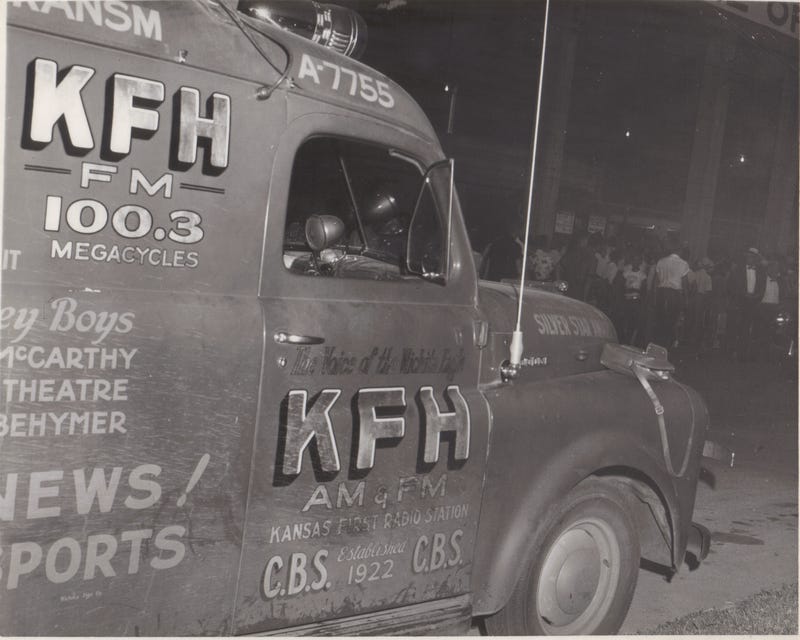
Gold Star – In 1952 KFH, in cooperation with Kansas law enforcement agencies, put together a Gold Star Safety Club, “So that a child may live.” Motorists were urged to drive through “safety lanes” and have their cars inspected for faulty brakes, lights, horns, and windshield wipers.
(pic with bus) – 130 city buses received the Gold Star. Pictured here are (left to right) Frank Webb, VP and GM of KFH; John Ebinger, president of Wichita Transportation Company; Traffic Sgt Pete Gregg; and KFH newscaster Bill Smith.
(pic with car “hardware” in the background) – 185 local cab companies received the Gold Star. Pictured here are (left to right) KFH newscaster Bill Smith, Rex Bulleigh of Vets Cab, Paul Martin of Yellow Cab, Opal Jones of Air Capital Cab, traffic officer John Stackey, Sgt Floyd Hannon Jr, and KFH GM Frank Webb.
Before KFH?
KFH is the oldest radio station in Kansas, but it was not the first, by only months. The first radio station in Kansas was here in Wichita: WEY.
Started by Cosradio Company March 23, 1922, it went black June 23, 1923.
Others:
WAH in El Dorado started by Midland Refining Company, March 28, 1922. Gone March 6, 1923.
WBL in Anthony started by T & H Radio Company, April 5, 1922. Gone December 15, 1924.
WTG in Manhattan started by Kansas State Agricultural College, April 6, 1922. Gone Dec 19, 1925.
WAAZ in Emporia started by Hollister-Miller Motor Company, April 13, 1922. Gone January 28, 1924.
WAAP in Wichita started by Otto W. Taylor, April 14, 1922. Gone October 15, 1923.
WDAD in Lindsborg started by William L. Harrison, May 15, 1922. Gone November 7, 1923.
WEAD in Atwood started by Northwest Kansas Radio Supply, May 25, 1922. Gone August 13, 1923.
WEAH in Wichita started by Wichita Board of Trade and Lander Radio, May 26, 1922. Now: KFH
Frank V. Webb – Vice President and General Manager of KFH, August 1948 until his death at age 48 from a heart attack in the early 1950s.
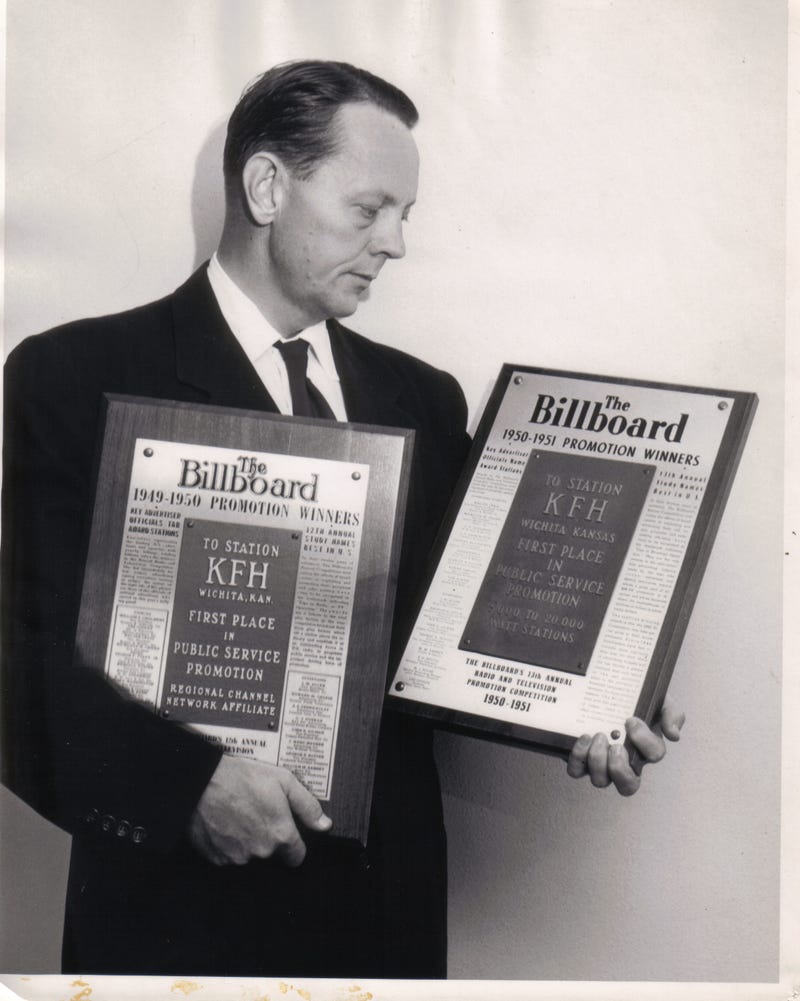
Instructions for KFH announcers – cir 1950
Wichita University – Before it was called Wichita State University, Wichita U broadcast football and basketball games on KFH. KFH at Wichita University Football Game:
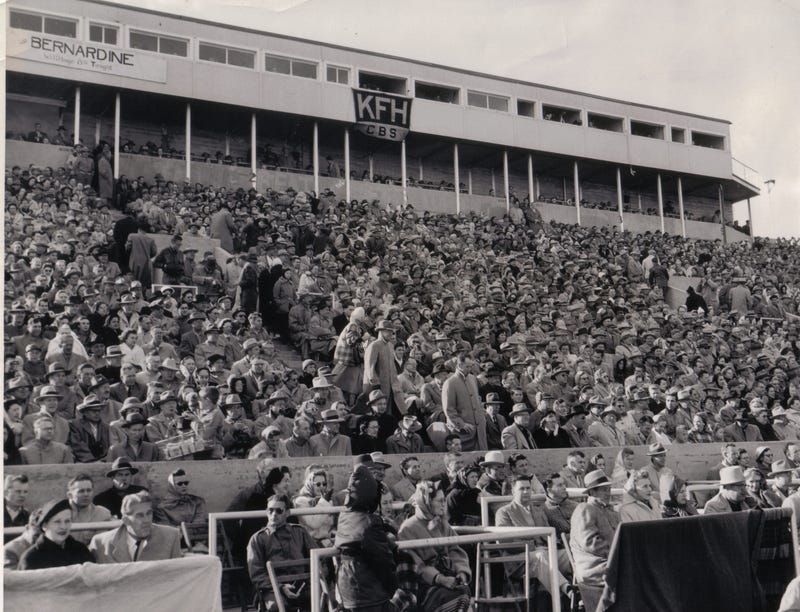
Cecil Carrier – Meteorologist
Cecil was a member of the US Weather Bureau (National Weather Service) in Wichita for eight years before entering the broadcast field in 1954. KFH was the only Wichita radio station that employed a fulltime weather expert. Cecil became very popular to the radio listening audience. He not only talked about what the weather would be like but always tried to present “why” the weather. In the 1960s, Cecil worked closely with KFH morning man Johnny Sanders.
(Pic with guy) Cecil pictured with KFH disc jockey Frank Stanton. Frank was known on the air as “Father Frank.”
John "Hooter" Myers – Morning Show
John came to KFH in the 1970s and was a very popular Wichita radio morning man through the 1980s.
(B&W photo) US Hockey Team in Wichita at Kansas Coliseum, January 1980. Those pictured with KFH jackets are KFH personalities. Hooter is standing wearing the headset.
Don Roberts – KFH Sales and Disc Jockey:
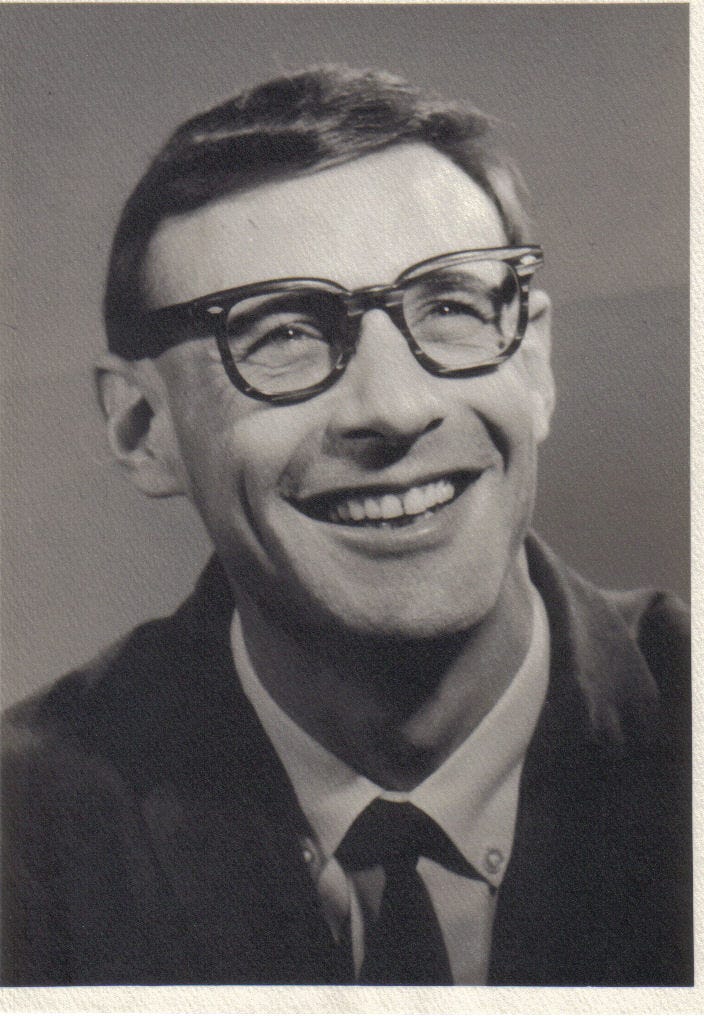
Fred Huddleston – KFH News 1970s – 1980s
Fred’s Midnight Police Report was extremely popular in Wichita. Each weekday at midnight on KFH, Fred would come on the air with a complete report on all police occurrences. Even the person that jaywalked earlier that day would be reported on in Fred’s midnight newscast.
(pic) – Fred is standing with the KFH News Team at the far left. (1980s)
Doree and Bill Post – Songwriters and musicians. Doree and Bill Post were popular personalities on KFH in 1953-1954.
At age 19, Bill Post left his family farm west of Arkansas City and headed for New York City. The year was 1939, and Post had only $100 earned from the wheat harvest in his pocket.
He planned to audition in New York to appear on that day's version of "American Idol." It was a nationally broadcast radio program called "Major Bowes' Amateur Hour." Post auditioned but didn't make it.
Though he didn't win an audition as a young Frank Sinatra he did take the first step in an exciting musical career as a singer-songwriter.
Post, at 86 in 2007, had boast many accomplishments, including being the composer of Kansas' official state march, "Here's Kansas."
Though Post worked in various entertainment jobs including as a member of an Air Force special services unit that entertained troops in India and Burma during World War II, his career didnhis career didn't take off until after he married his first wife, Doree, in 1947.
The couple formed a songwriting team that produced several songs that were recorded by nationally known artists including Connie Stevens, The Lettermen, Eddie Cochran, Bobbie Vee and Lawrence Welk.
Bill wrote the lyrics and Doree wrote the music.
Through an agent, the two were booked as a singing team to entertain for six hours a night at a bar and restaurant in upstate New York.
In Washington, Bill Post arranged for him and Doree to audition for the president of MGM Records. The audition was a success and the couple signed a contract to do several records -- "Peace in the Valley," "The Auctioneer's Love Song," and "I Wish We Were Sweethearts 50 Years Ago." The latter two were written by the Posts.
One day, the Posts learned that Warner Brothers Records were looking for possible songs for Connie Stevens to perform. She was coming to town the next week, he said.
Stevens recorded the Posts' song, "16 Reasons," which became the biggest hit the couple made, he said. It was featured in the 2001 movie, "Mulholland Drive."
In 1961, Doree died of cancer. The couple had lived in California then but were planning to move back to Kansas. Doree is buried in Mt. Hope Cemetery.
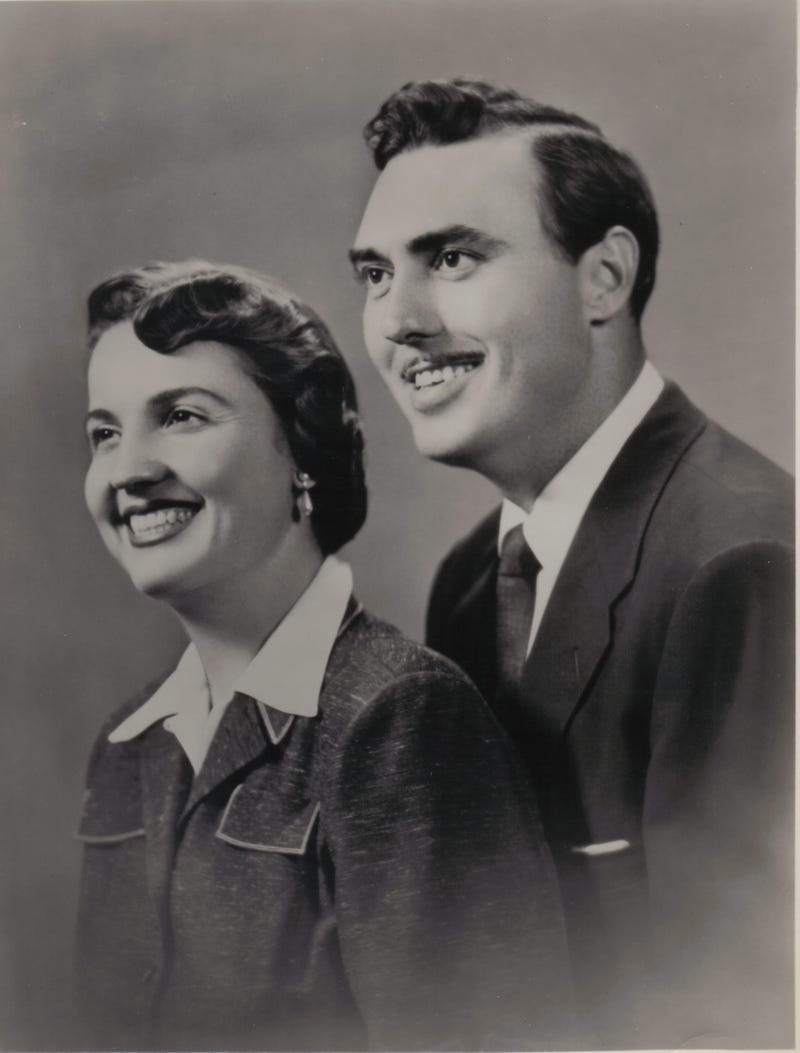
KFH Public Service – KFH history is so involved in Wichita public service. In each year from 1949-1955, KFH was awarded national awards for public service from Billboard trade magazine. VP and GM Frank Web is pictured with awards.
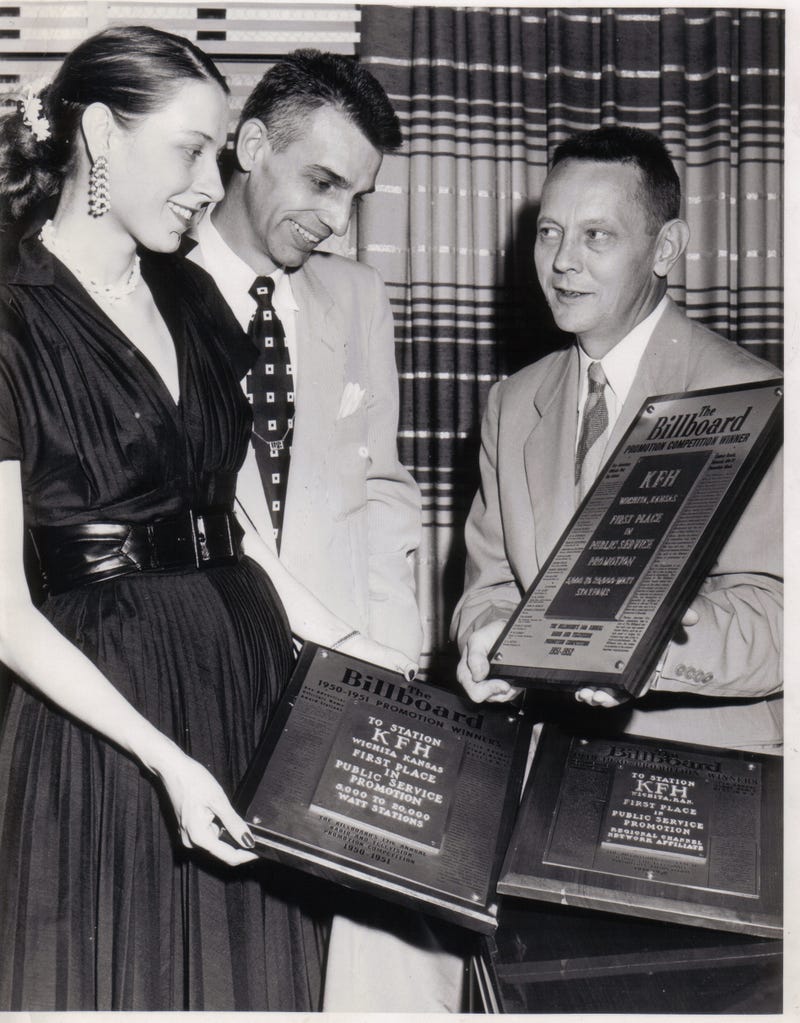
Ark Valley Boys – Band
The Ark Valley Boys had a daily show on KFH.
Group members included:
Bill Wimberly, lead, vocals
Cotton Wittington, left-handed steel guitar, vocals
Gene Crownover, steel guitar
Buddy Kindricks, bass, vocals
Gene Casaway, fiddle
Jack Atchley, piano
Doris Buss, accordion
Bill Boggs, fiddle
Corky Edminster
Note: Doris, Bill and Corky were part of the original Ark Valley Boys but in 1949 left KFH and went to radio station KANS as the “Coral Gang.”
The act performed various types of tunes such as swing, Western band selections and included vocals by Buddy, Cotton and Bill.
The original Ark Valley Boys were led by Corky Edminster, who was with the group from 1939 to 1949. After Corky, and most of the other band members left to go to KANS Radio, the band was led by Tex Ferguson, who brought in his group, the Drifting Pioneers, to become the new version of the Ark Valley Boys. (Note: KFH owned the name, Ark Valley Boys.)

Tex Ferguson left in 1953. That’s when Bill Wimberly took over the reins of the Ark Valley Boys. Wimberly was only at KFH for around two years before he moved to Springfield, MO to become a part of Red Foley’s Ozark Jubilee. Frank Baughman, who was one of the later members of the band and had been hired by Bill Wimberly. Frank was #53 or 53 of those who had been members of the Ark Valley Boys. The Ark Valley Boys disbanded in 1955.
Certainly, the most-significant version of the Ark Valley Boys was the original version of the band. They are also one of THE most important bands in the history of Country Music in Wichita. The most interesting part of the short time that Bill Wimberly led the Ark Valley Boys was that he hired Gene Crownover and Gene Gasaway, who both went on to be members of Bob Wills’ Texas Playboys.
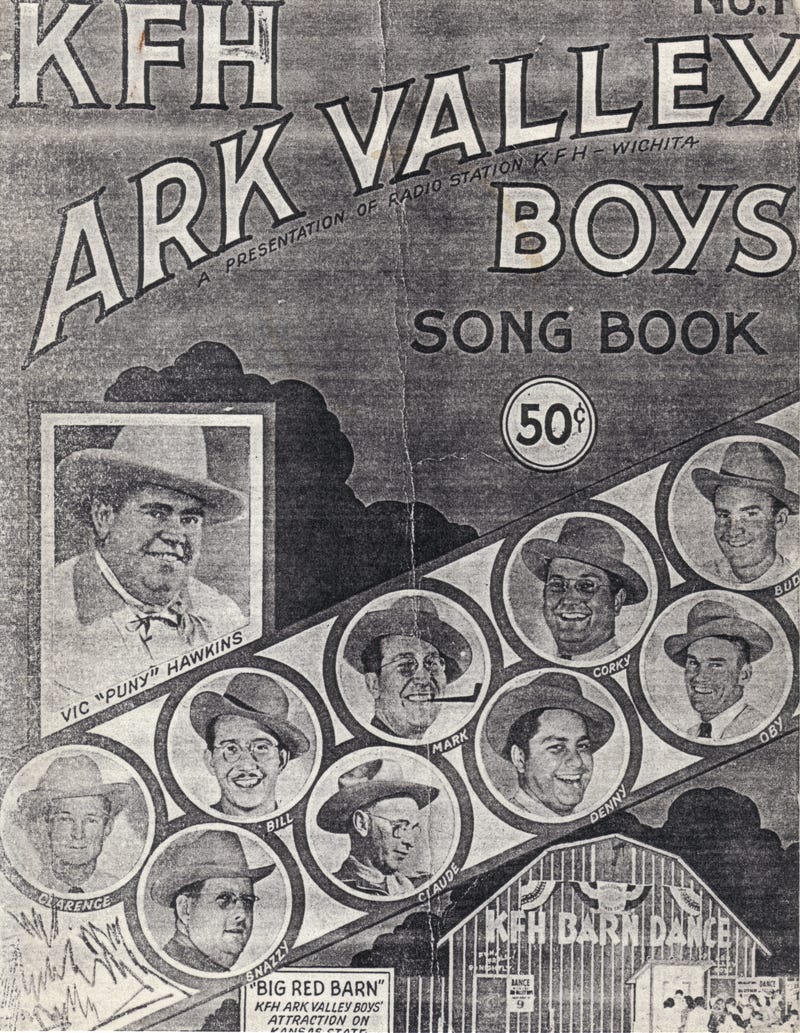
If you need an example of the group's popularity in KFH's listening area, the station offered a free photo to fans that wrote and requested it. The station was swamped with over 4,000 requests.
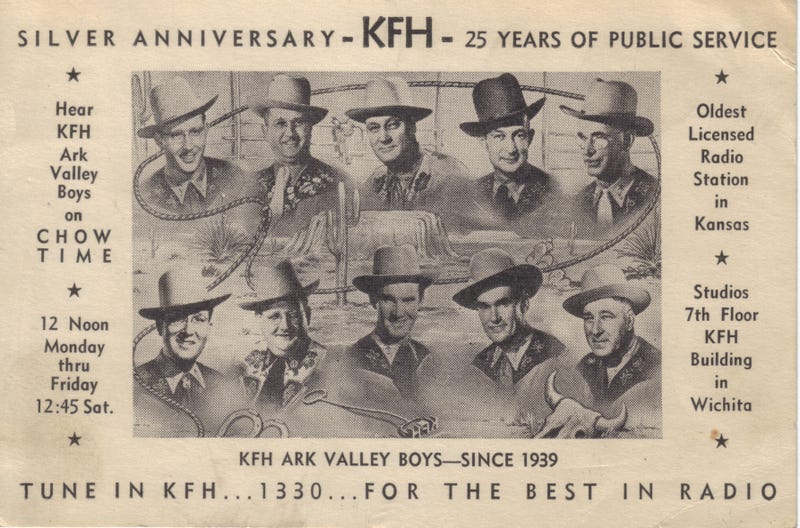
Rick Weaver – Sports
“Rick Weaver in your receiver” was Rick’s slogan as he started many broadcasts.
Rick did what many sports play-by-play announcers only wish they could do, everything. Rick broadcast games, from high school to pro sports. In 1963 Rick was the voice of the Dallas Cowboys. He also broadcast Wichita University (Wichita State University) games. Rick also broadcast State and National Baseball tournaments on KFH and nationwide to 30 stations from Florida to Alaska. Rick appeared on such network shows as the Ed Sullivan Show, Arthur Godfrey, and CBS Sports Television. Rick worked alongside national icons like Harry Carey in St Louis. Rick interviewed stars like Rock Hudson, Jayne Mansfield, and Mickey Mantle.
In 1971 Rick took a job with the Miami Dolphins as their radio voice. He stayed with the Dolphins for 23 seasons, through 1993, calling games in the historical 1972 season when the Miami Dolphins became the only NFL team to this day to go an entire season undefeated and winning the Super Bowl.
(pics with 2 men) Rick pictured here with Johnny Weissmuller. Johnny was one of the world's best swimmers in the 1920s, winning five Olympic gold medals and one bronze medal. He won fifty-two US National Championships and set sixty-seven world records. After his swimming career, he became the sixth actor to portray Tarzan in films, a role he played in twelve motion pictures. Other actors also played Tarzan, but Weissmuller was the best-known. His distinctive, ululating Tarzan yell is still often used in films.
Uncle Ben and Cousin Betty – cir 1930/1945
Benjamin Franklin Hammond worked as a cartoonist for the Wichita Eagle from 1912 to 1965. In addition to editorial and historical drawings, he is best-known for his cartoon characters, “Hoots” and “Quacks” which appeared in the newspaper and in real life as puppets in performances for local groups. For 25 years, Hammond also broadcast a weekly radio program in which he read the Eagle’s Sunday funnies. He is pictured here with his daughter, Geraldine Hammond, who often joined him or substituted for him. The pair was known on the KFH program as Uncle Ben and Cousin Betty.
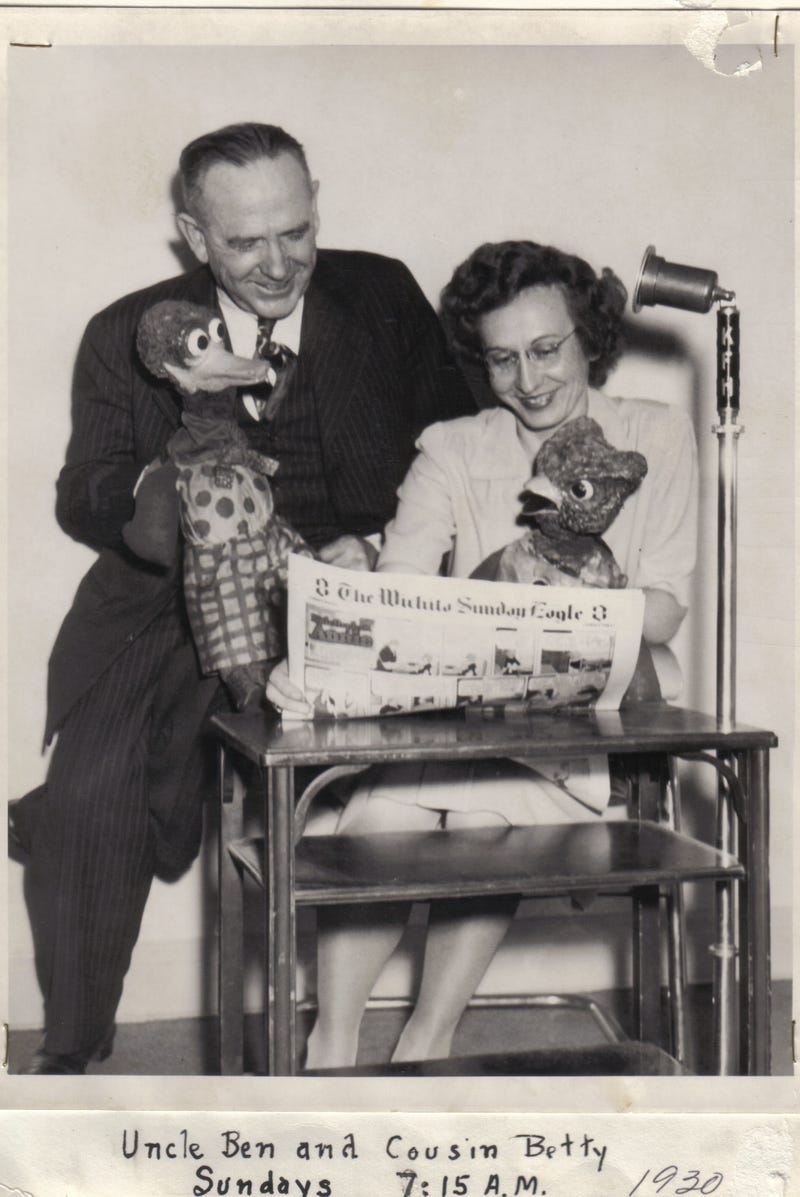
Ethel Jane King – EJ’s Notebook:
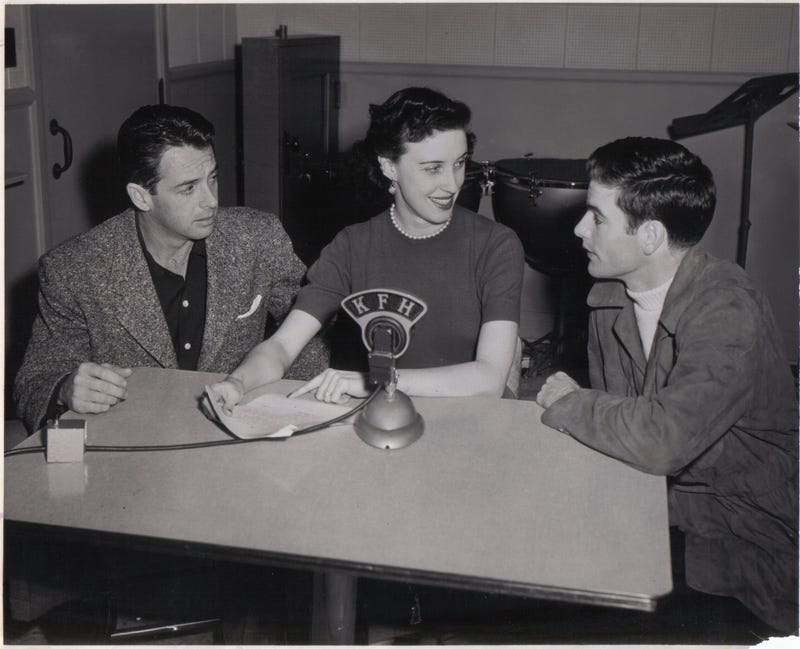
John Heckman – KFH News
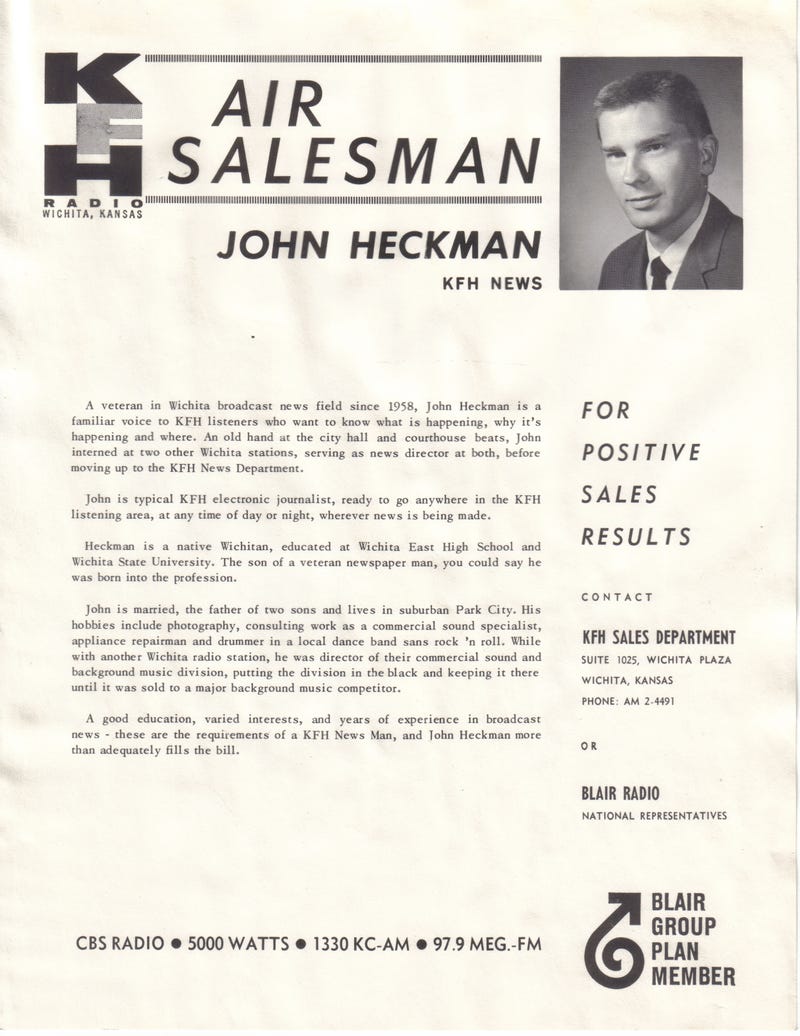
Jay Harmon – Personality
Jay worked at KFH in the late 1950s. He was a news announcer and sports announcer. But of his many talents was doing impressions. He was “Wallace” on the Johnny Merrell Show. Wallace was a daily feature of the show. Jay also voiced many other characters on KFH.
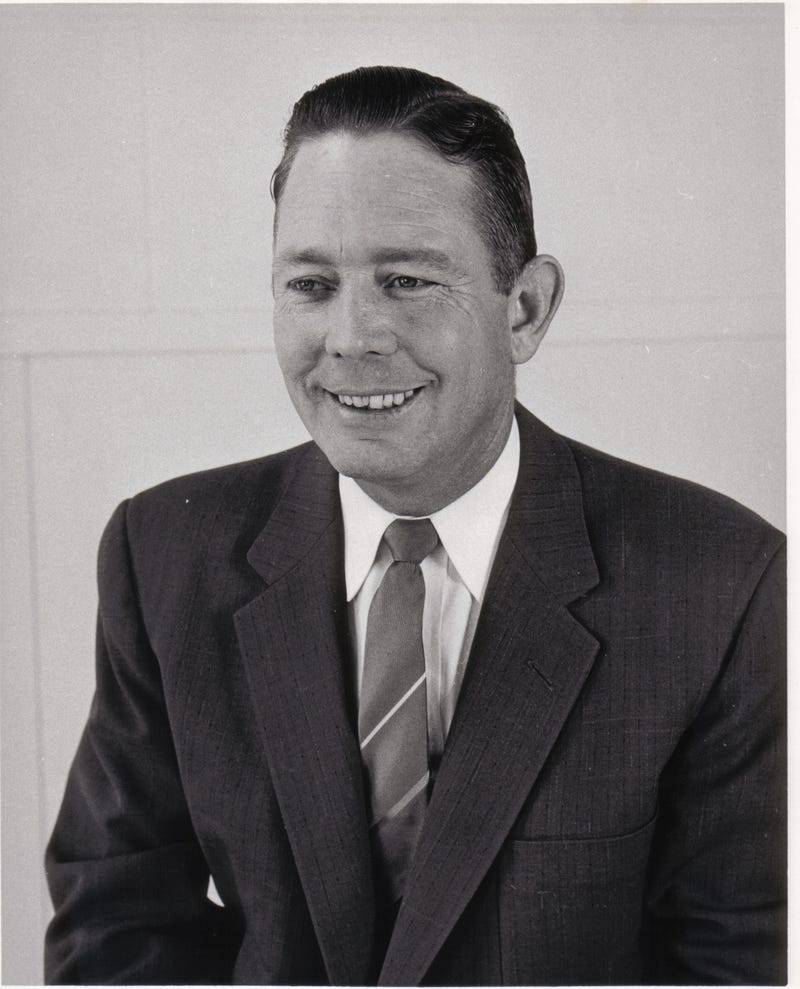
30 Years of KFH – Feb 26, 1952:
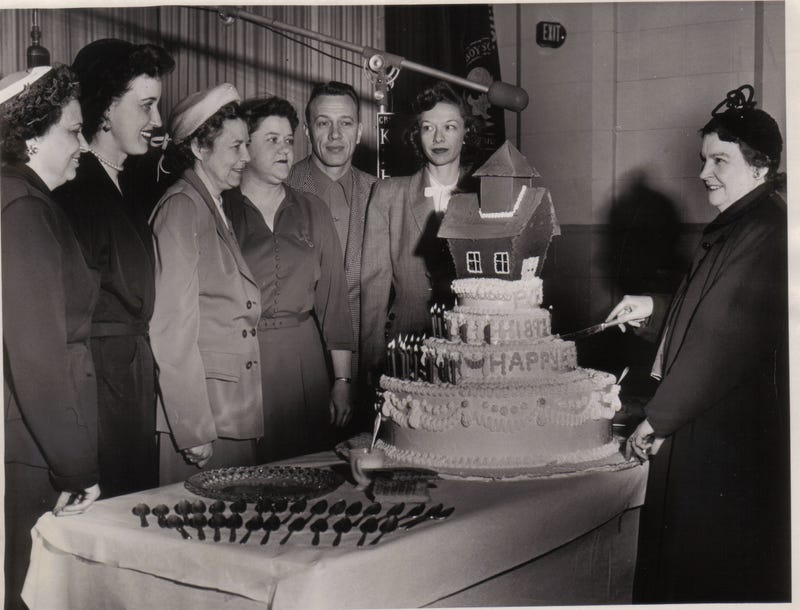
40 Years of KFH – 1962:
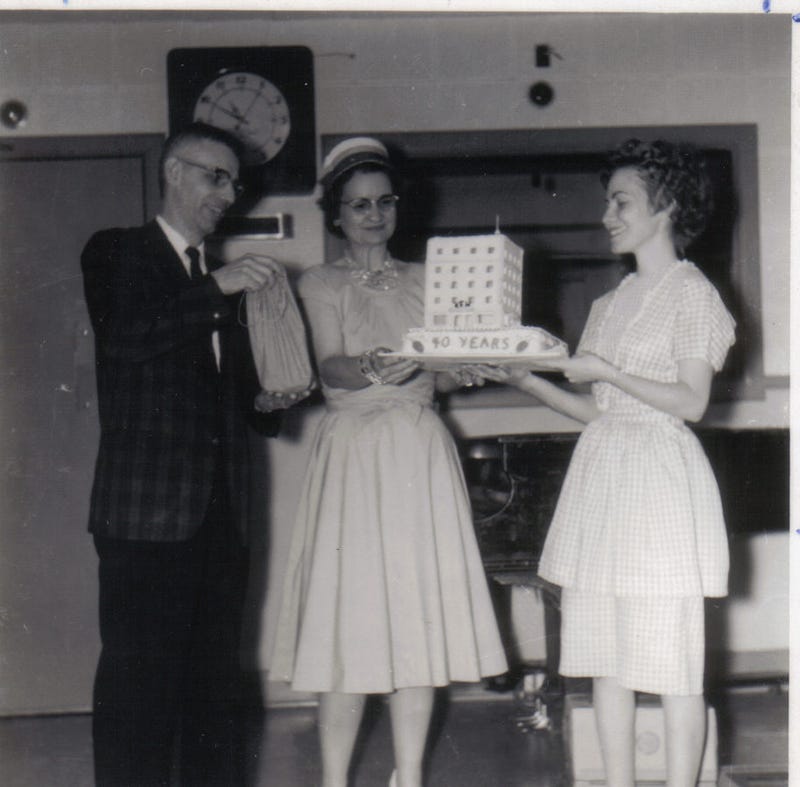
Roy Randall – KFH Personality. Pictured in the KFH Building, located at William and Market:
Roy was born in Wichita, Kansas on July 10, 1932. He was raised in Beloit. When he was 17 he enlisted in The United States Army. Just after basic training our grandfather was deployed to Korea in 1950, with the 2nd Infantry Division; he assigned to Co. A 38th Infantry Regiment. He was there from Pusan to Mount Redoubt in the North & fought in Chinese offensive. After Korea he was stationed in Japan where he met his wife Aiko, they immediately fell in love and married each other. After his term of service Roy came back to Kansas, then sometime during the 60's moved to Southern California with his wife and 3 children. He spent many years here working in construction, and on his free time he was an avid artist, and writer. He always reminisced and shared stories of his time working at a great radio station in Wichita. Roy had 10 grandchildren, and 10 great grandchildren. Roy passed away on July, 3 2012 in West Covina, California.
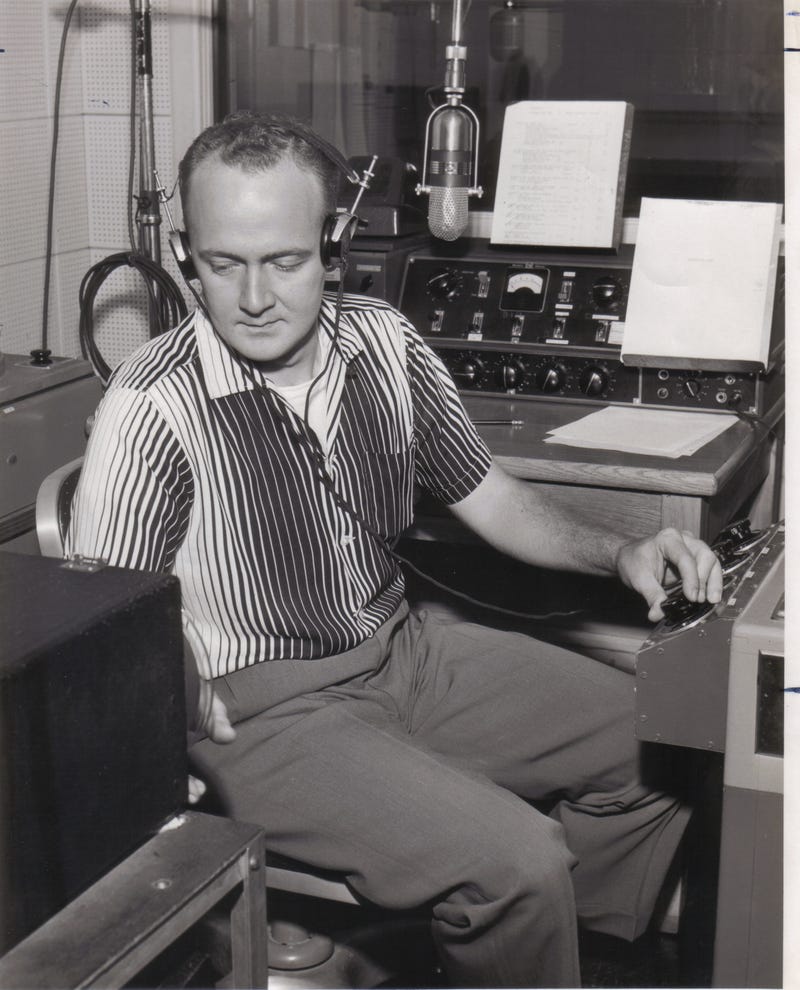
1984 KFH
(pic with pointing hand) Familiar billboard in downtown Wichita, pointing to KFH building across the street, Douglas and Emporia.
(pic with man) Inside KFH main control room. Personality Wade Cooper is pictured here, along with control board and ‘carts’ along the back wall. Each cart would hold one piece of audio. The audio piece could be a commercial spot, station jingle, or a song.
(2 studio pics below) KFH production room where commercials were produced for clients. Turntables and multi-track reel-to-reel machines were the latest technology of the day. Just a year later of this picture taking, the compact disc player was introduced.
2007 KFH? (written in 2007)
In 2007, KFH AM and FM is still entertaining South-Central Kansas with programs from Wichita and around the country. Just as in the ‘ol days when KFH featured great national radio personalities from Bob Hope to programs like CBS Mystery Theater, KFH 2007 brings to Wichita a radio legend with Don Imus, a sports broadcasting icon with Jim Rome, and one of the most popular shows in Wichita afternoon radio, for over a decade: Don & Mike!
KFH also is home to the most popular local talk show, Sports Daily with Bruce Haertl and Bob Lutz. In early 1980s, Bruce started his broadcast career in radio as Sports Director at KFH before leaving to TV. Almost 20 years later Bruce returned to KFH with Sports Daily, a weekday show airing 9a-11a. Sports Daily is the most popular local talk show in Wichita. Anyone who is a sports fan knows about Sports Daily.
In celebration with KFH’s 85 years of broadcasting (2007), KFH is introducing HD Radio to its format in 2007. HD Radio brings with it very high quality sound of KFH’s current main channel lineup, plus an additional bonus channel: KFH HD 2! KFH HD 2 will be called the “Radio Ha Ha” channel, delivering comedy stand-up and bits 24/7 … all commercial-free.
Jackie Wise, General Manger – Started in sales at age 21 in early 1980s. Today, Jackie is one of the top broadcast GMs in the city, managing 5 radio stations of very different formats.
Tony Duesing, Program Director – In 1983, Tony started working in radio (at KFH) right out of high school at age 18. Working his way up through mostly music-formatted radio stations, he was given the chance to run KFH in early 1990s. Tony now programs both KFH and KNSS Radio in Wichita.
1922?
The Bureau of Navigation, a division of the Department of Commerce, regulated United States radio until the 1927 formation of the Federal Radio Commission. In 1934 the Federal Communications Commission succeeded the FRC.
It was in 1920 when the first radio station in the country went on the air, KDKA in Pittsburgh. In 1921, 25 radio stations went on the air. Then in 1922, the year KFH went on the air as WEAH, on an almost daily basis radio stations were going on the air all across the country. In fact there were so many radio stations going on the air with the standard three-call letter signs, the Bureau had to start issuing four-call letter signs. Before the crunch the Bureau was able to assign three-letter call signs to about 200 broadcasters.
Just imagine a time when there was no TV, no cell phones, and not even radio. Then 1922 comes around and this new device called a radio could not only inform but entertain! It was only the beginning to a transformation on how people not only were going to get their news, but to also to hear music and radio shows.
All broadcast station activity in three-letter calls did not cease following the 1922 switchover to four-letter calls, as about half of today's holders of three-letter calls trace their first assignment to later than 1922. In many cases these post-1922 calls were not the station's first, but were ones they changed to some years later. Some calls were claimed when a previously authorized broadcaster or other station expired. And many of these calls were specially requested to tie-in with a slogan or licensee name: “Kansas Finest Hotel (Lassen Hotel); "World's Largest Store" (Sears); "World's Greatest Harbor" (Norfolk, Virginia); "World's Greatest Newspaper" (Chicago Tribune); "Woodman Of the World"; "We Shield Millions" (National Life), etc. The last new three-letter call assignment, excluding reassignments of previously used calls or FM and TV sister stations, was WIS (now WVOC), "Wonderful Iodine State" in Columbia, South Carolina on January 23, 1930.
Jack Munley – KFH Sports Director. Later, Jack went to work at KTVH (now KWCH) Channel 12 as Sports Director.
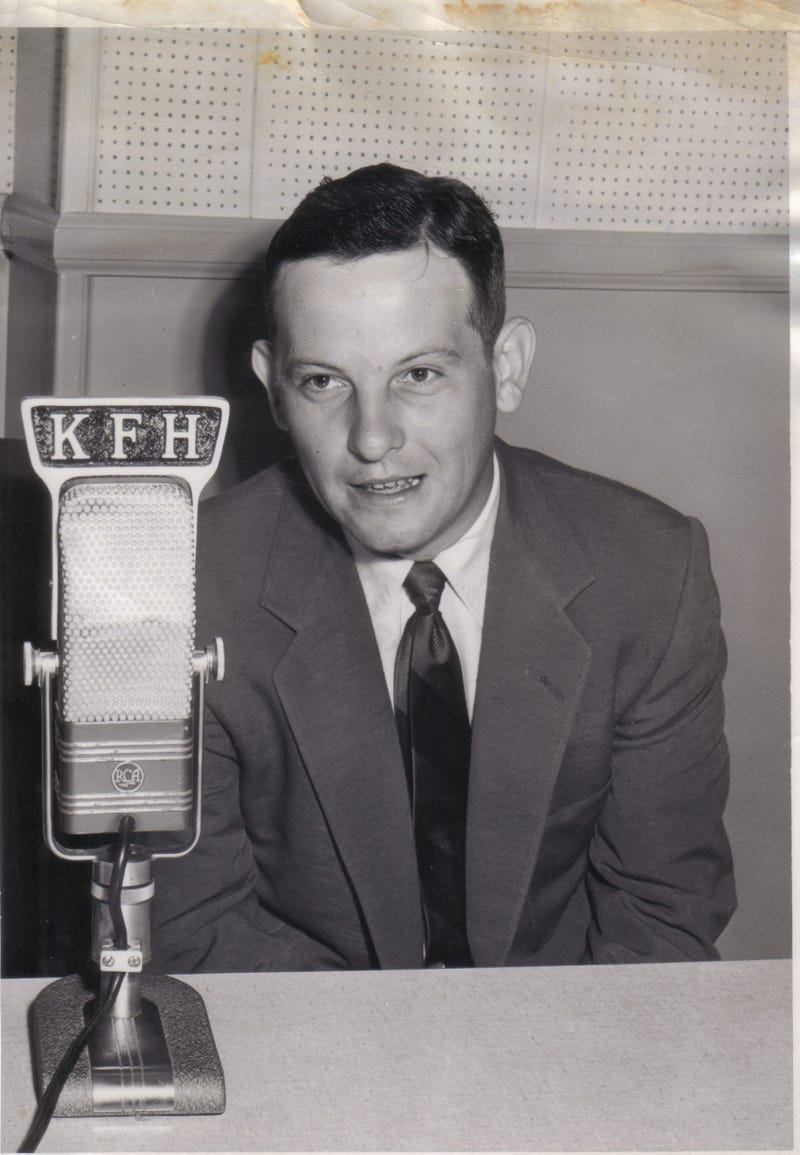
Gary "Dick" Rippy, "The Round Mound of Sound" was PD and morning man late 60s-early 70s until he bought a station in the Texas panhandle:
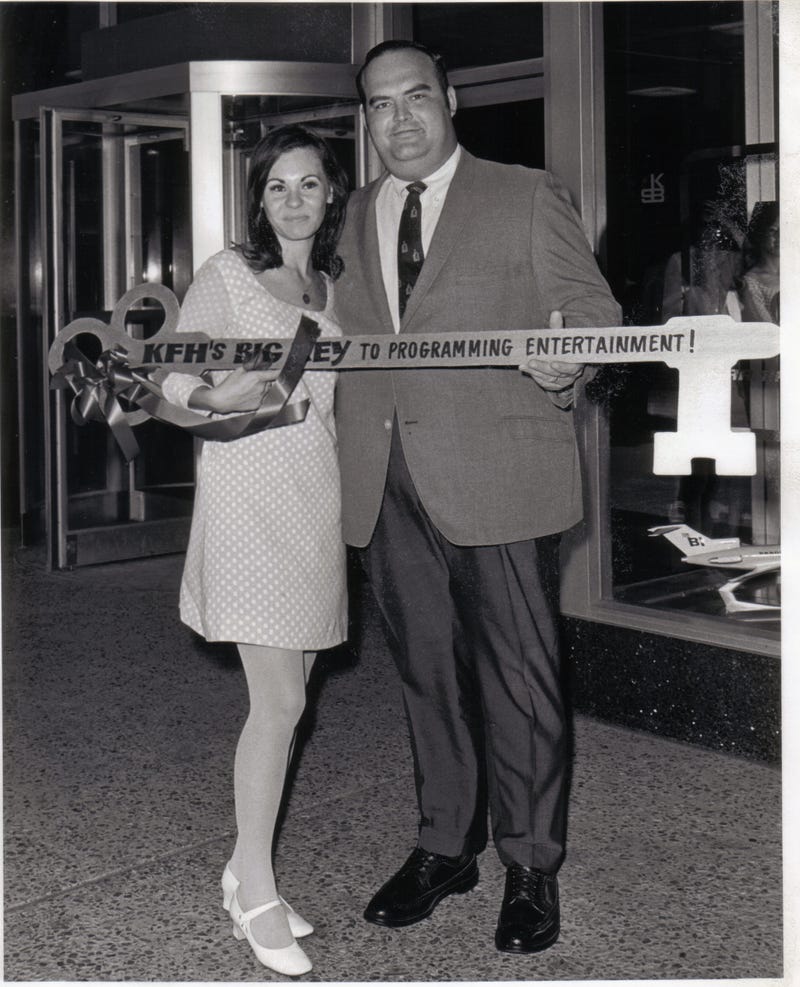
Channel 97 – An idea that started with Barry Gaston in the late 1960s. KFH FM was a station that started playing “underground rock.” Channel 97 (KFH FM) became one of the most popular radio stations in Wichita, esp among young people, as Channel 97 featured the hot, new and edgy rock songs of the day, many of which other radio stations would not play.
The decade's youth culture helped spur the growth of FM stations. Listeners were antitelevision and anticonformity and could find a similar rebelliousness in the songs and programs on FM radio. Progressive rock stations took root in San Francisco, Los Angeles, New York, Boston, and Wichita, eliminating advertising jingles and the antics of AM disc jockeys.
How does radio work?
A simple process … a radio receives electromagnetic waves from the air that are sent by a radio transmitter. The radio converts these electromagnetic waves, called a signal, into sounds that humans can hear.
Guglielmo Marconi successfully sent the first radio message across the Atlantic Ocean in December 1901 from England to Newfoundland. Marconi's radio did not receive voice or music. Rather, it received buzzing sounds created by a spark gap transmitter sending a signal using Morse code.
The radio got its voice on Christmas Eve 1906. As dozens of ship and amateur radio operators listened for the evening's traffic messages, they were amazed to hear a man's voice calling "CQ, CQ" (which means calling all stations, I have messages) instead of the customary dits and dahs of Morse code. The message was transmitted by Professor Reginald Aubrey Fessenden from a small radio station in Brant Rock, Massachusetts.
On November 2, 1920 the first commercial radio station went on the air in Pittsburgh, Pennsylvania. It was an instant success, and began the radio revolution called the "Golden Age of Radio." The Golden Age of Radio lasted from the early 1920s through the late 1940s.
During this Golden Age, the radio evolved from a simple device in a bulky box to a complex piece of equipment housed in beautiful wooden cabinets. People would gather around the radio and listen to the latest news and radio plays. The radio occupied a similar position as today's television set.
Breakfast Frolic – On Friday, Sept. 9, 1955, KFH’s morning show broadcast for over an hour from a helicopter hovering over Wichita. This was another KFH first.
This broadcast was presented in conjunction with the Kansas Naval Air Show in Hutchinson.
(pic below) Left to Right: KFH GM Frank Webb, Helicopter Pilot Lt. Byrle Vaughn, KFH Personality Don Anderson.
(pic below) Early 1950s live radio performances from the KFH Building Theater. By the 1960s, the theater was no longer used and sat empty:
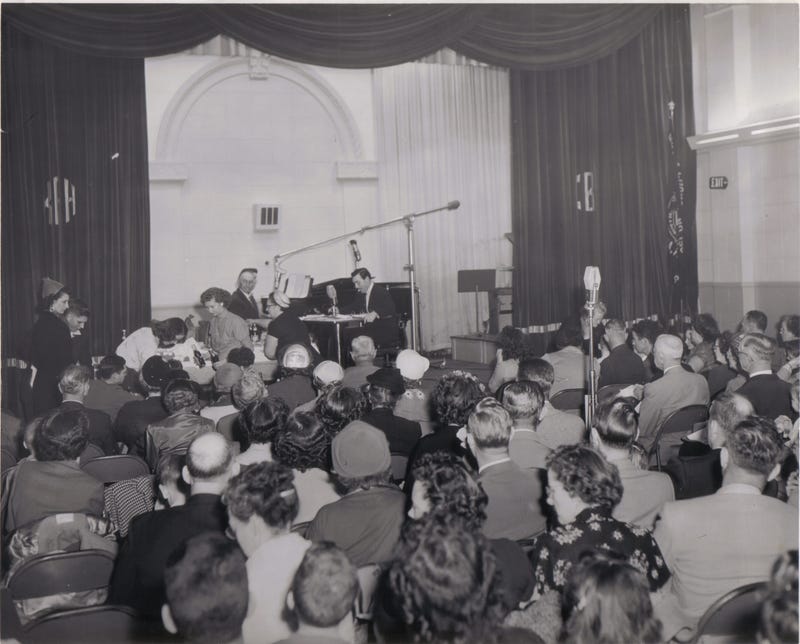
Mac Sanders – KFH personality who later went on to purchase and run radio stations, including starting KICT FM in Wichita as a country radio station:
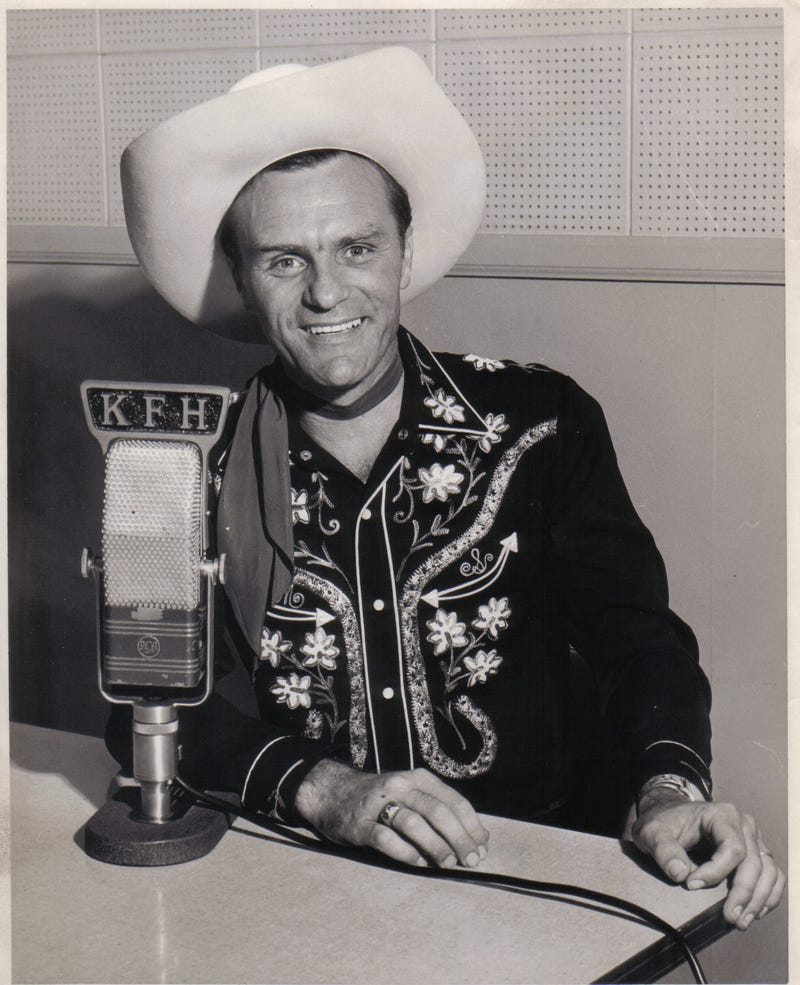
KFH Studio entrance at the KFH Building, William and Market. Cir 1955:
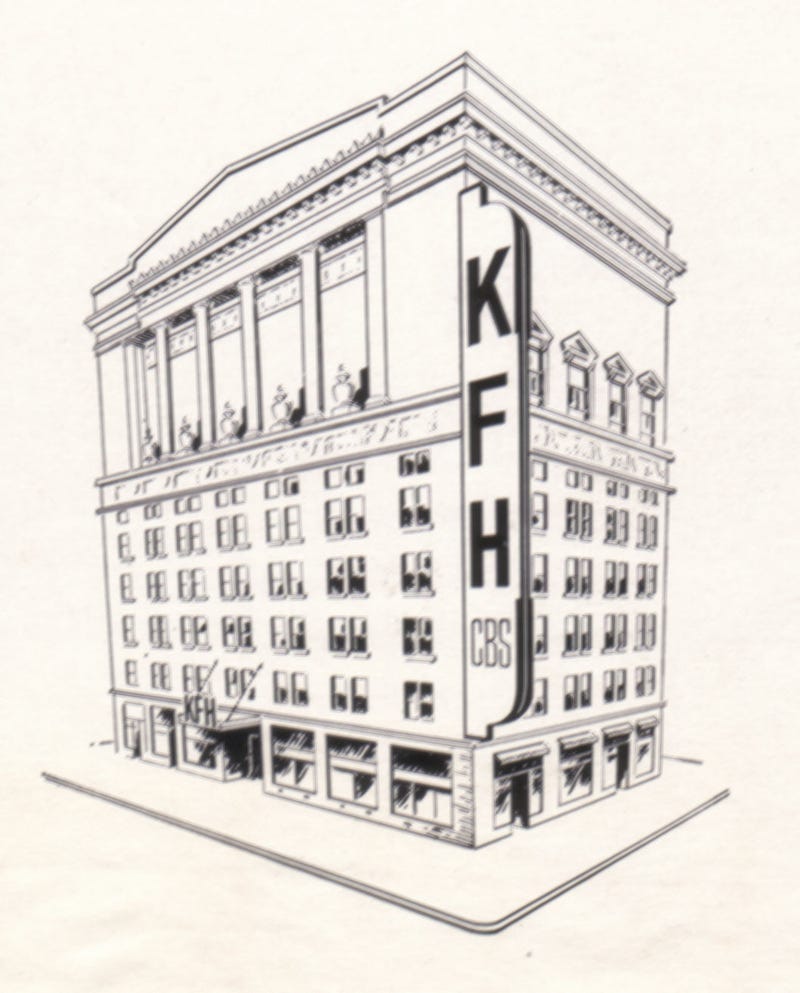
Lowell Thomas - Traveling to remote sites around the world, Lowell Thomas brought news and a sense of adventure into America’s living rooms. However, it was not just the news story that captured his listener’s imagination, but Thomas himself.
Born on April 6, 1892, in Woodington, Ohio, Thomas grew up in Cripple Creek, Colorado. He pioneered radio journalism with a career that spanned 50 years. He made his first sojourn to the battlefield during World War I, and began a daily newscast on NBC in 1930. Thomas later worked for CBS News during his long globetrotting career.
Thomas was the first reporter to enter Germany following World War I, bringing back eyewitness accounts.
Between his standard opening—“Good evening, everybody”—and his closing—“So long until tomorrow”—people knew they were hearing a solid, objective voice of authority.
Before his career in radio, from 1919–1922 Thomas traveled the world, writing and lecturing. Thomas said his ambition was “to know more about this globe than anyone else ever has.”
During World War II, Thomas broadcast detailed accounts of the war, often from a mobile truck behind front lines.
Lowell Thomas died on August 29, 1981.
Lowell Thomas was inducted into the Radio Hall of Fame in 1989.
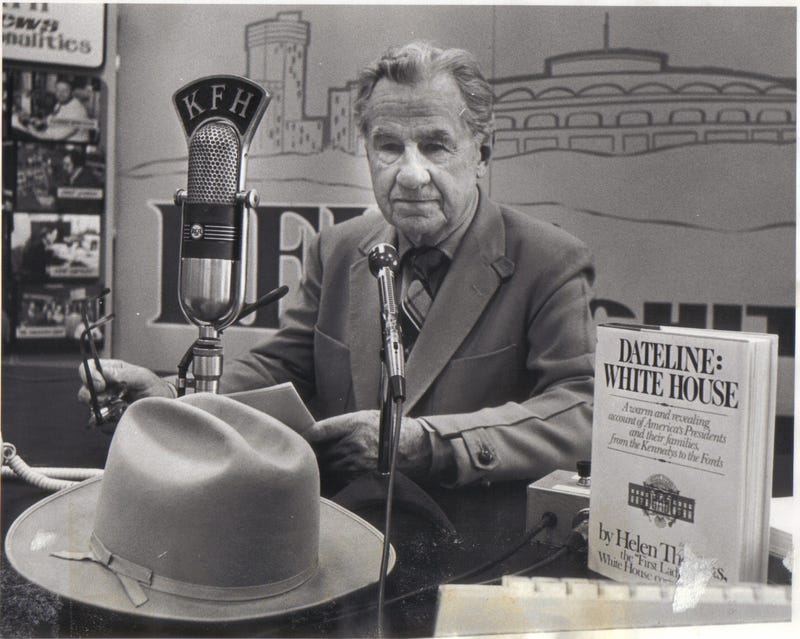
KFH Personalities Don Anderson and Ethel Jane King. Cir 1950s at Home Show:

KFH Personality Father Frank Stanton with Rex Allen Jr. – Rex’s is know for his golden voice and a true dedication to his music and career. A consummate actor, singer, songwriter and entertainer, Rex Allen Jr. was the narrator in the movie Me, Myself and Irene.
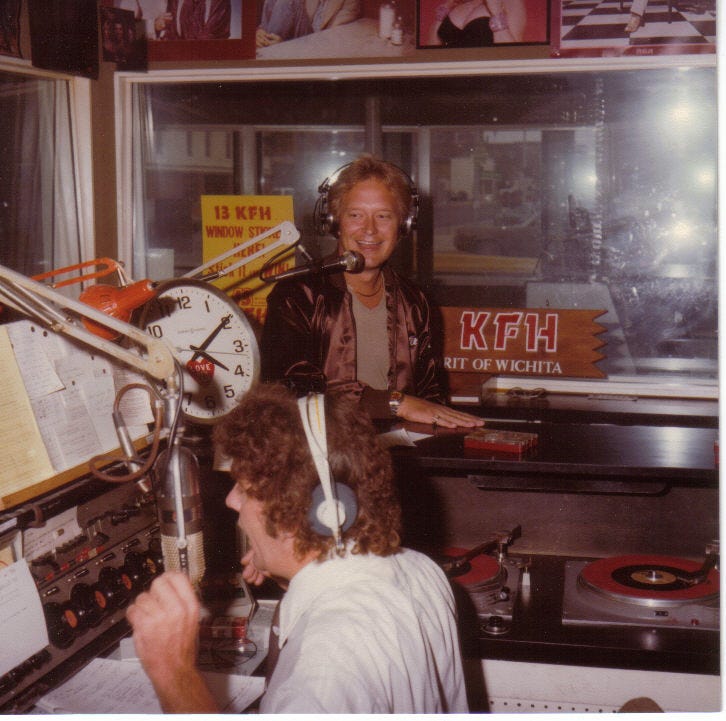
In late January of 1923 the Mississippi River, the current standard, was adopted as the dividing line for radio station call letters. This meant new call grants in North and South Dakota, Nebraska, Kansas, Oklahoma, Texas, Iowa, Missouri, Arkansas, and western Minnesota and Louisiana became K's rather than W's. However, existing stations west of the Mississippi were permitted to keep their now non-standard W calls. Thus, pioneer broadcasters such as WKY Oklahoma City, Oklahoma, WOI Ames, Iowa, and WHB Kansas City, Kansas remain as monuments to the period before the boundary change. (pic: http://earlyradiohistory.us/kwbigmap.gif)
Ken Softley – KFH Sports Announcer 1967 – 1980:
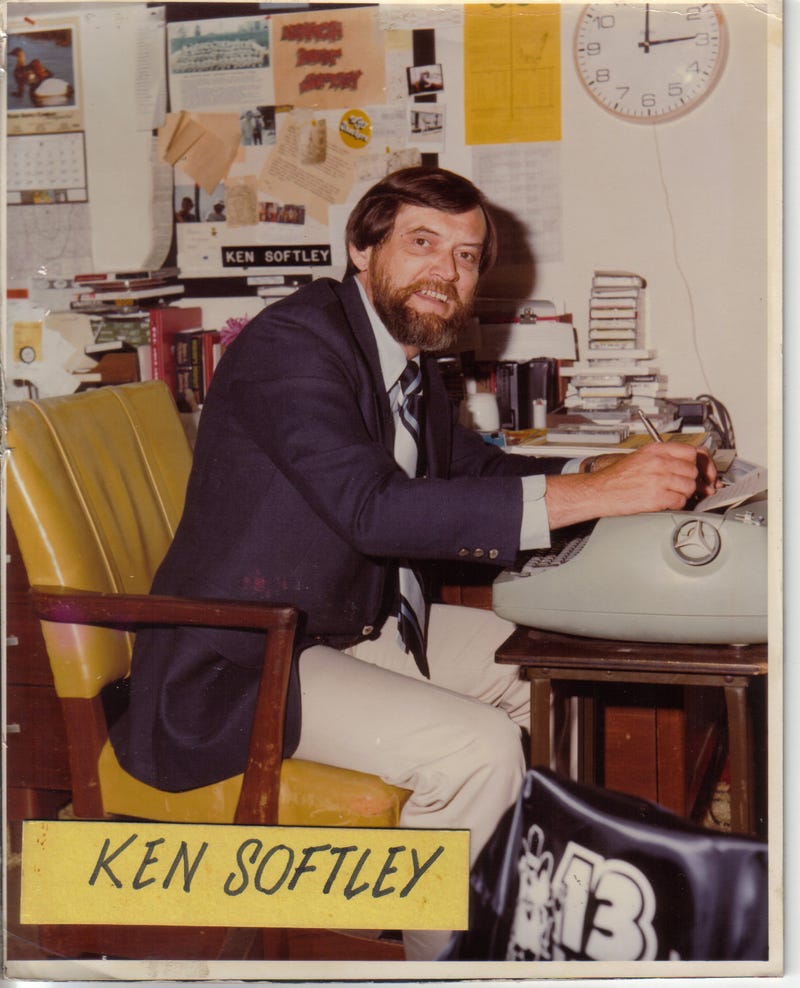
William Inge - Noted playwright William Inge is a native of Independence in southeast Kansas who used his hometown family and friends as fodder for his sometimes scandalous plays. But before he became "The Midwestern Tennessee Williams," Inge was a radio announcer at KFH in Wichita. His dreams of a broadcast career didn't last very long. He soon left to become an English teacher in Missouri and then to evolve into the playwright known for such classics as "Come Back, Little Sheba," "The Dark at the Top of the Stairs" and "Picnic."

The One Hundred Oldest Stations in the United States
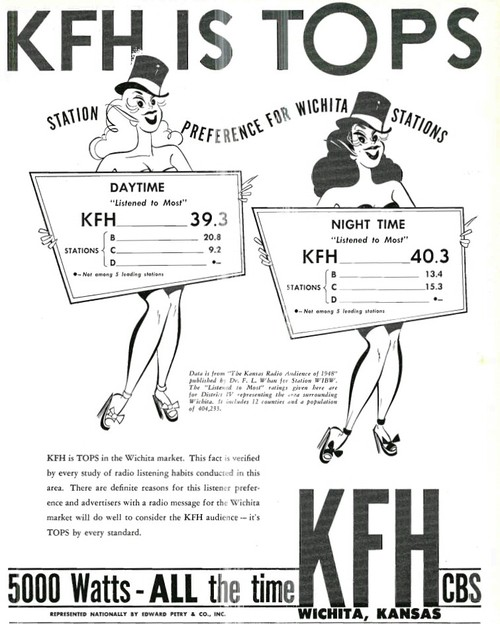
Houdini was on KFH (WEAH) when we're only 1 year old! He was to perform at The Orpheum Theater, which also was only 1 year old.
